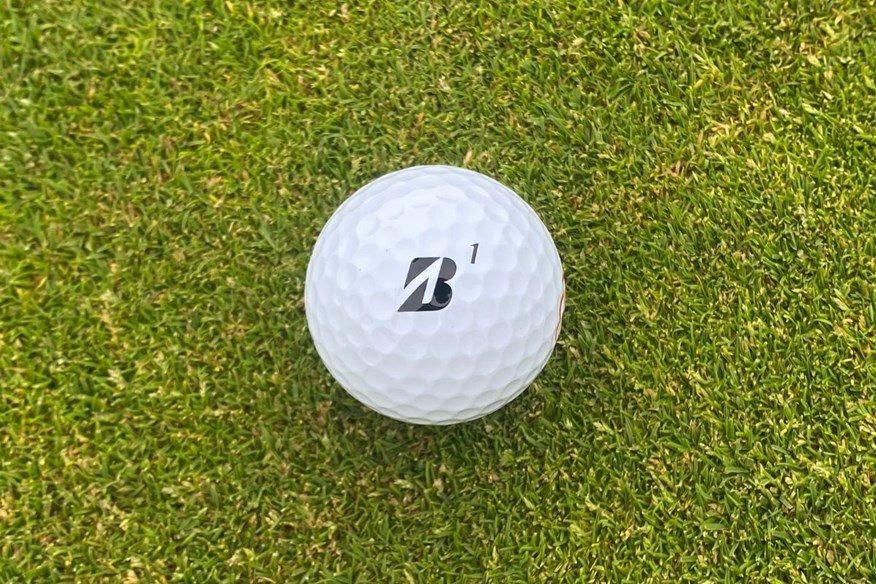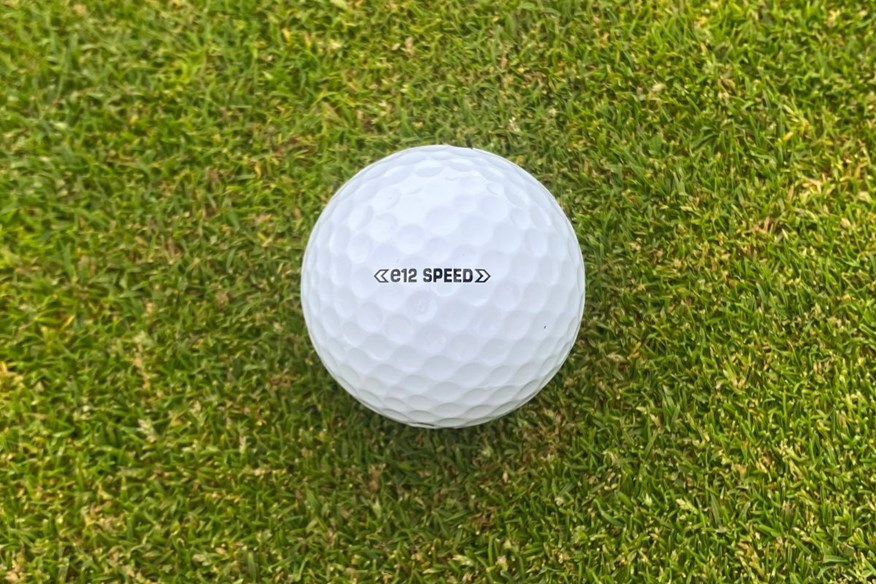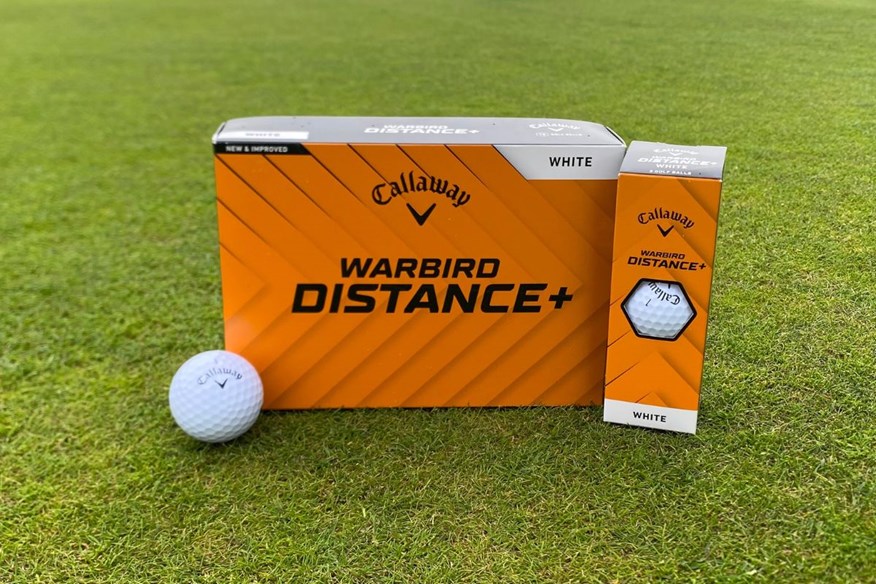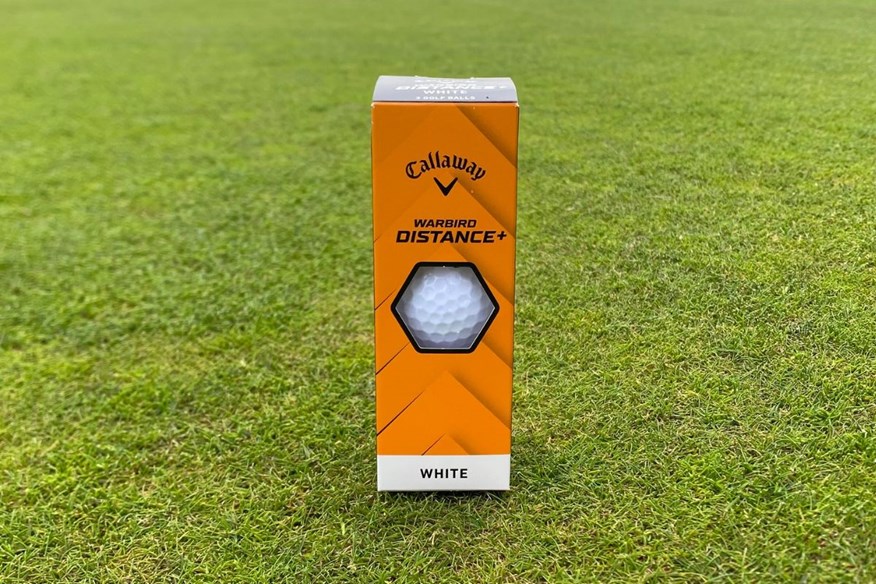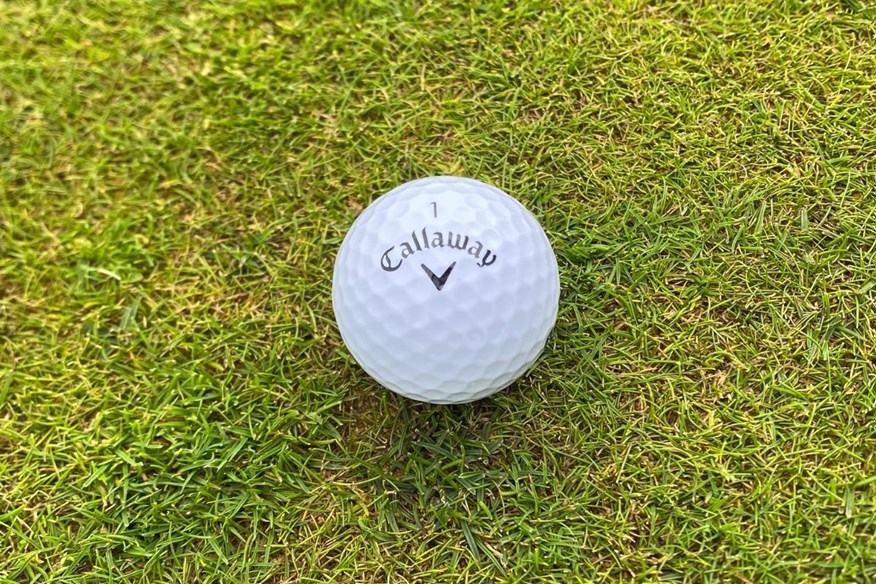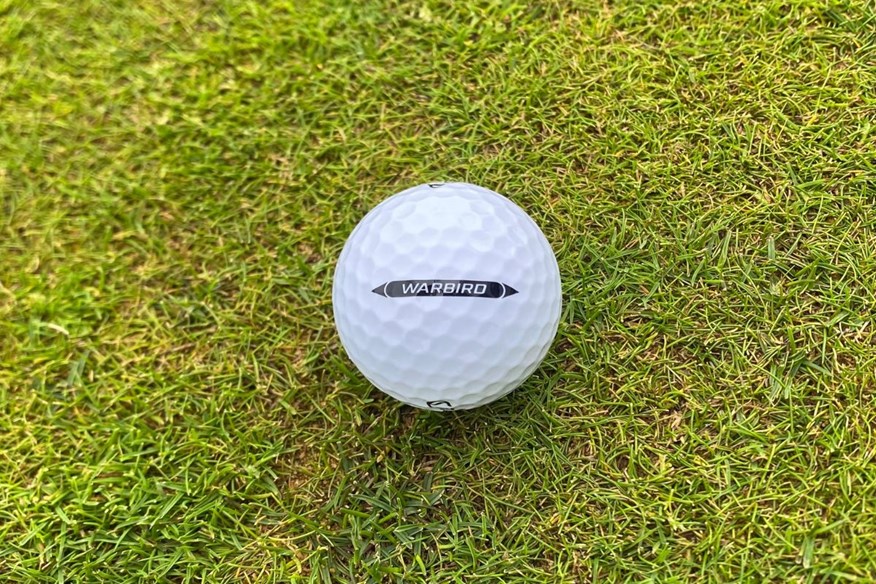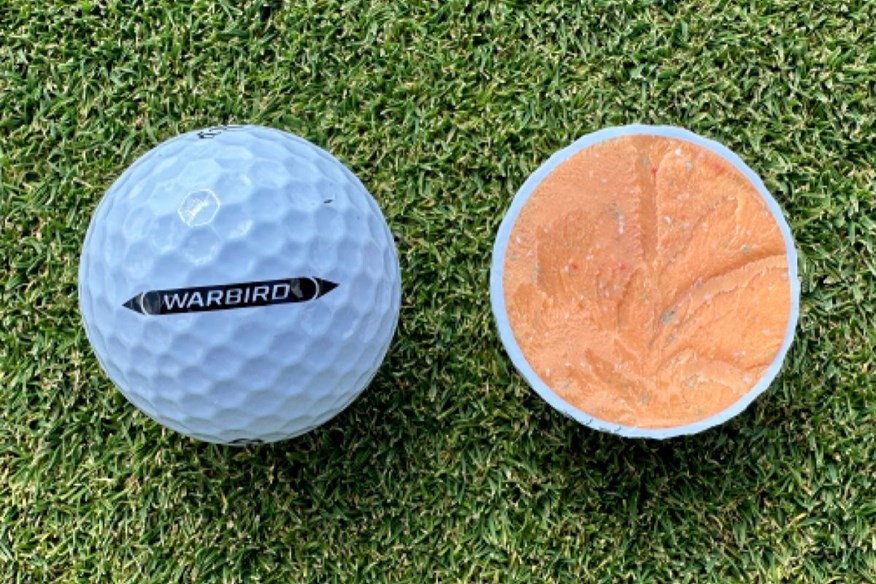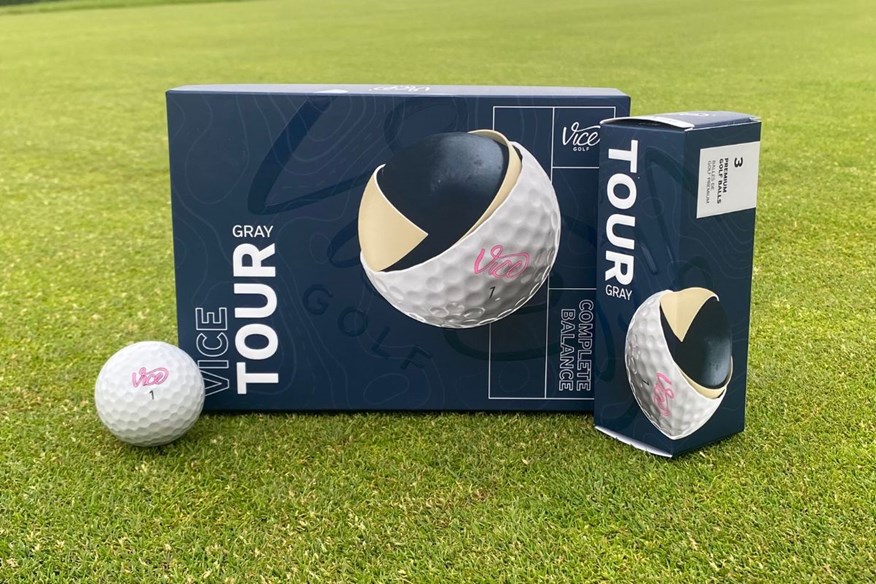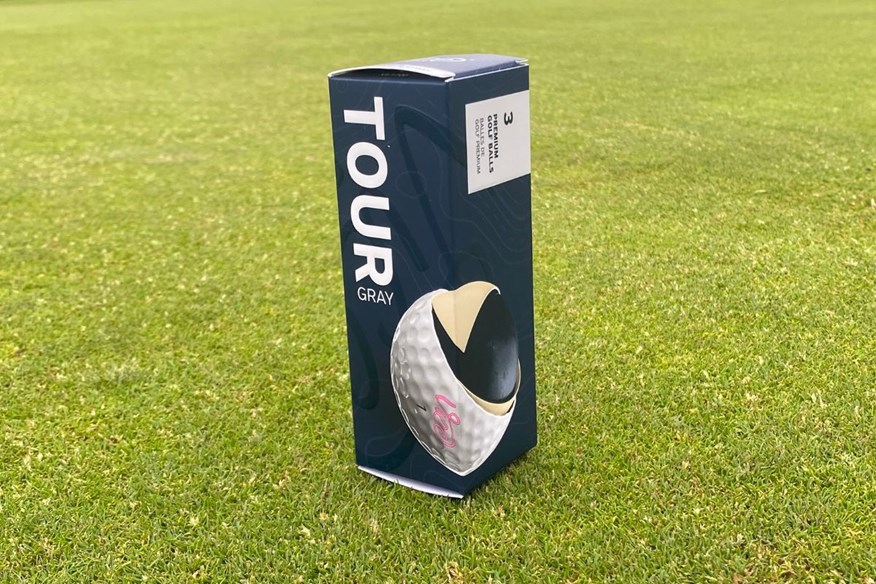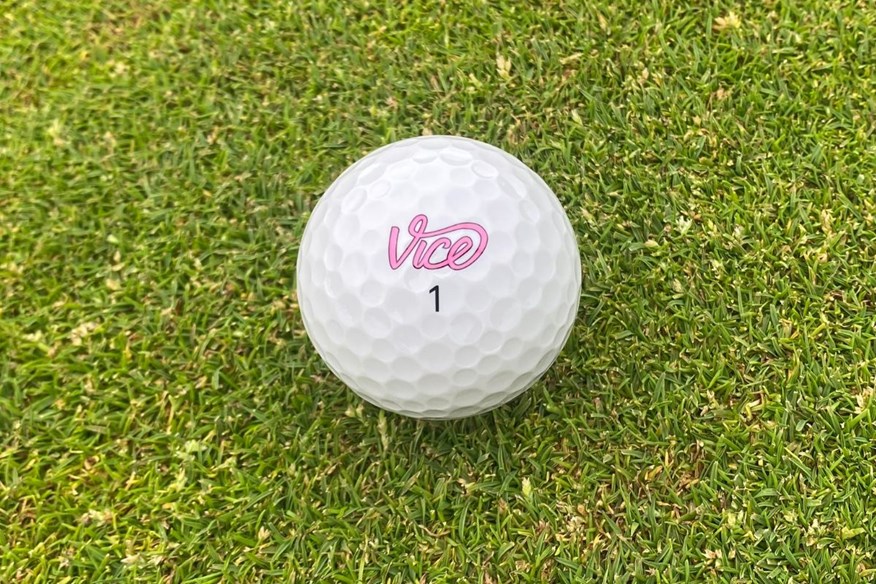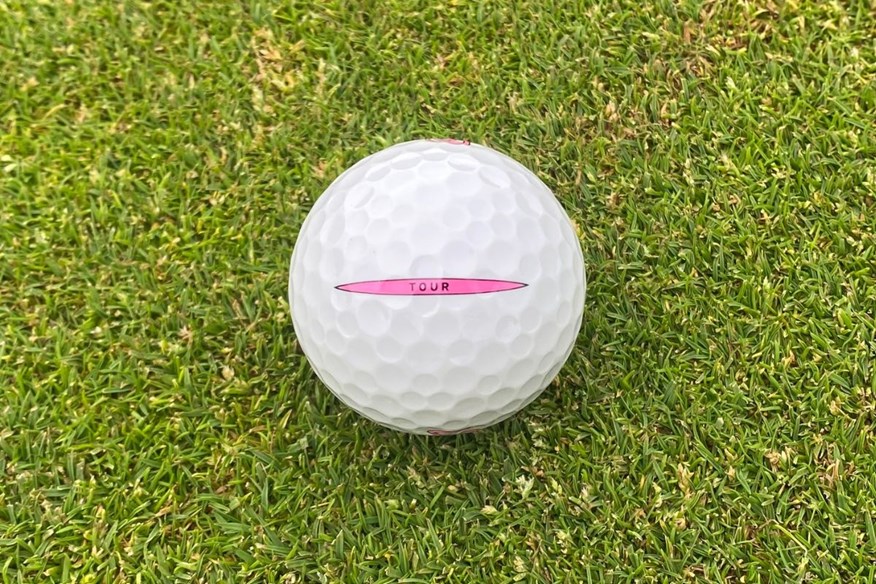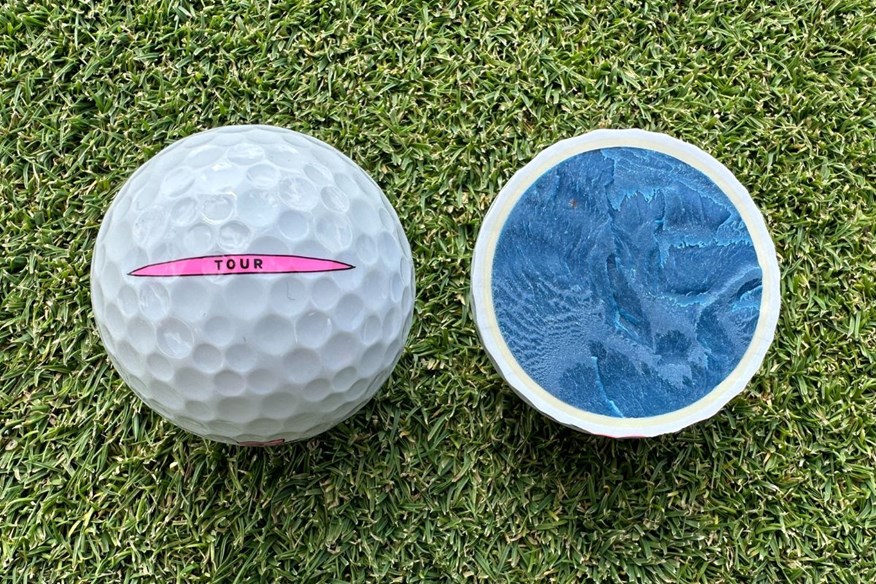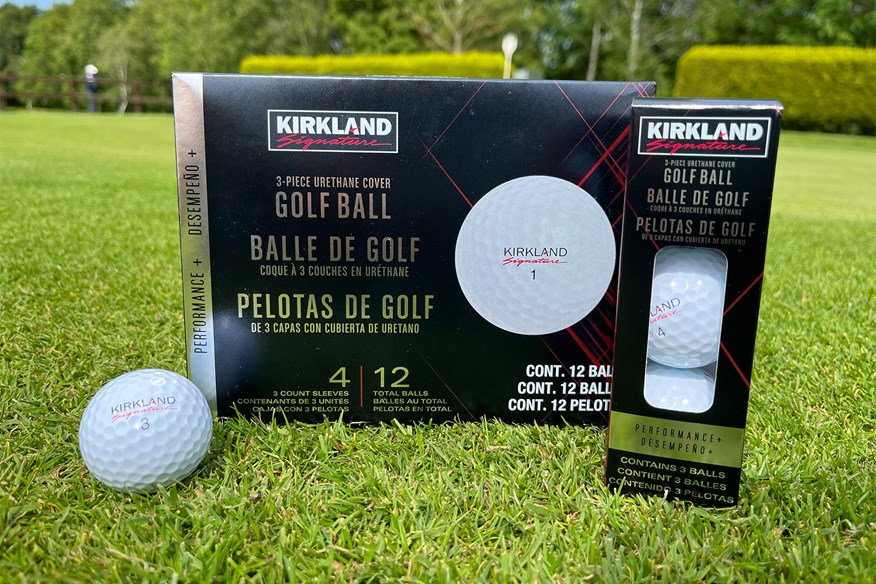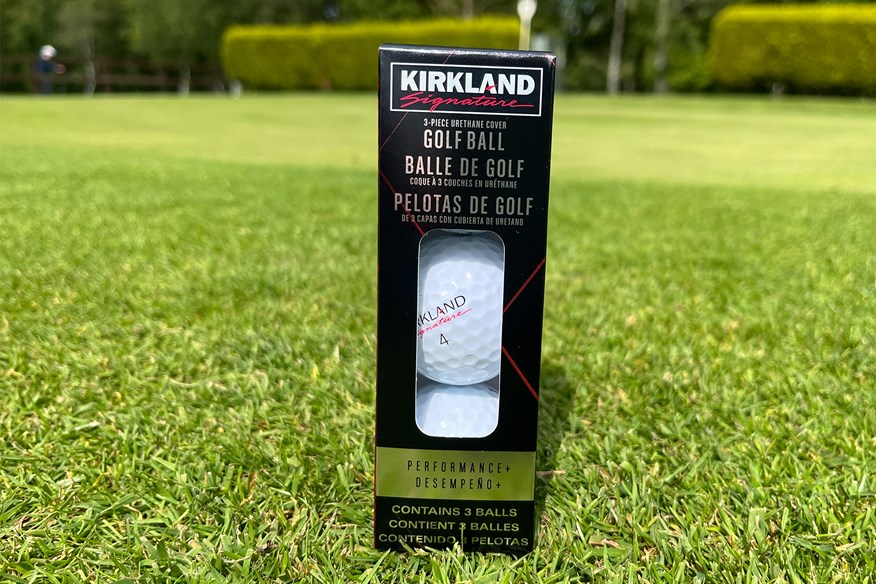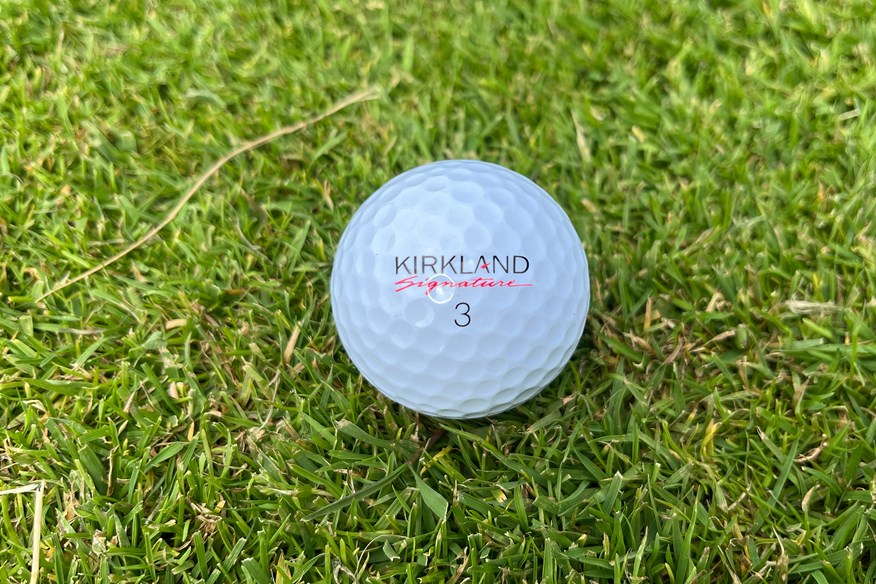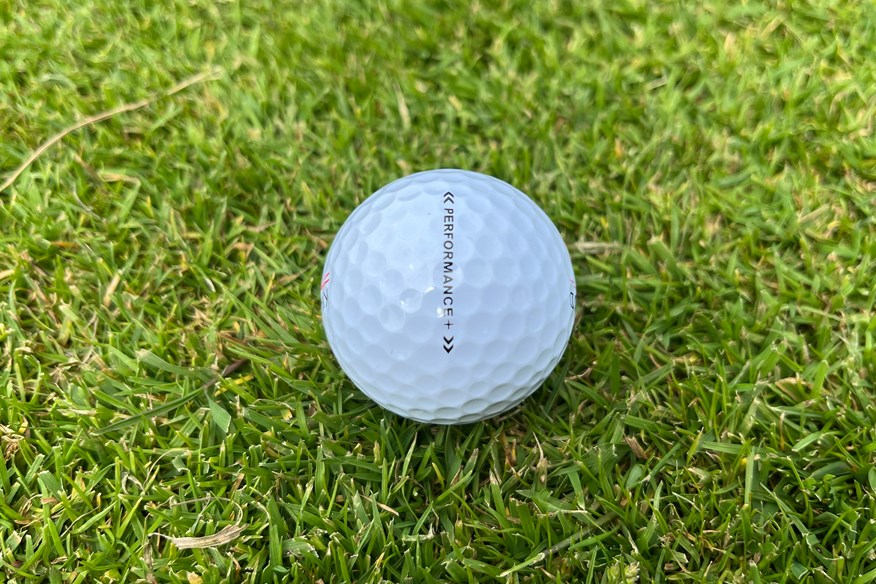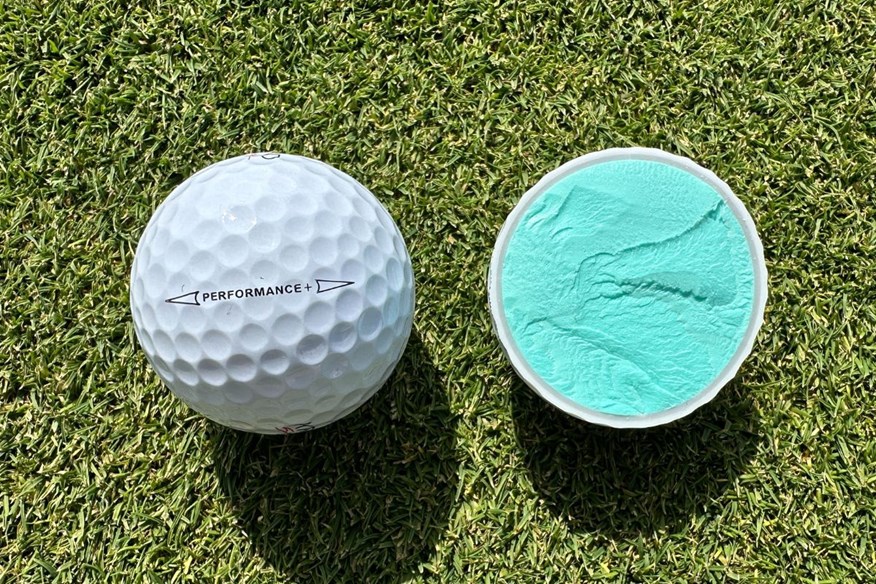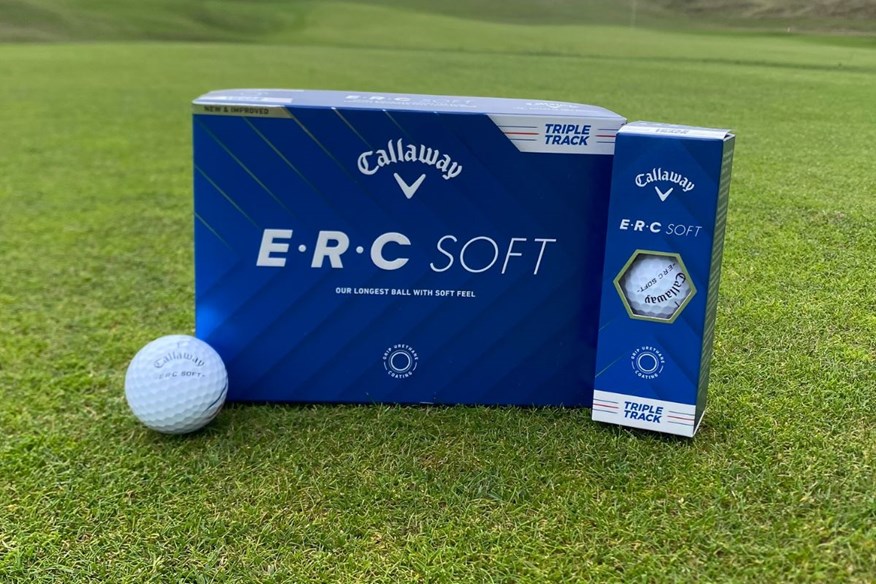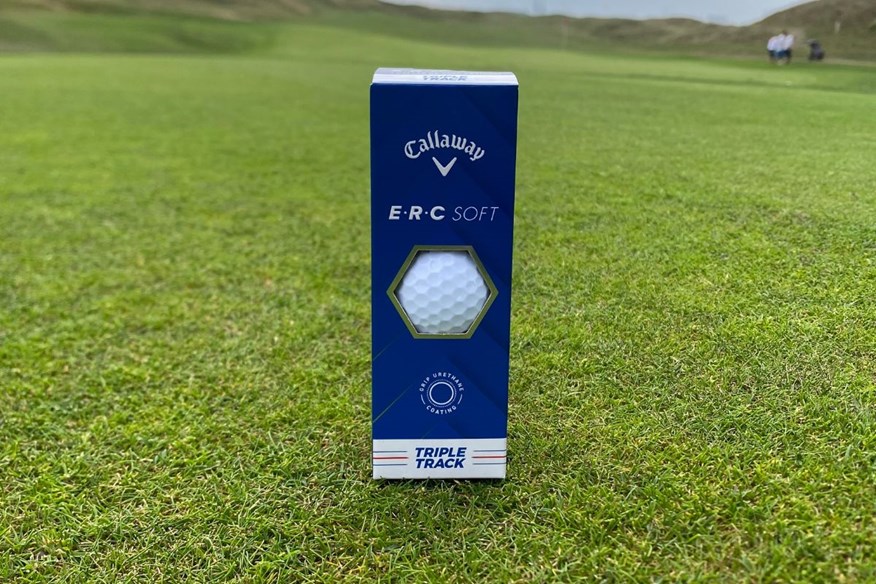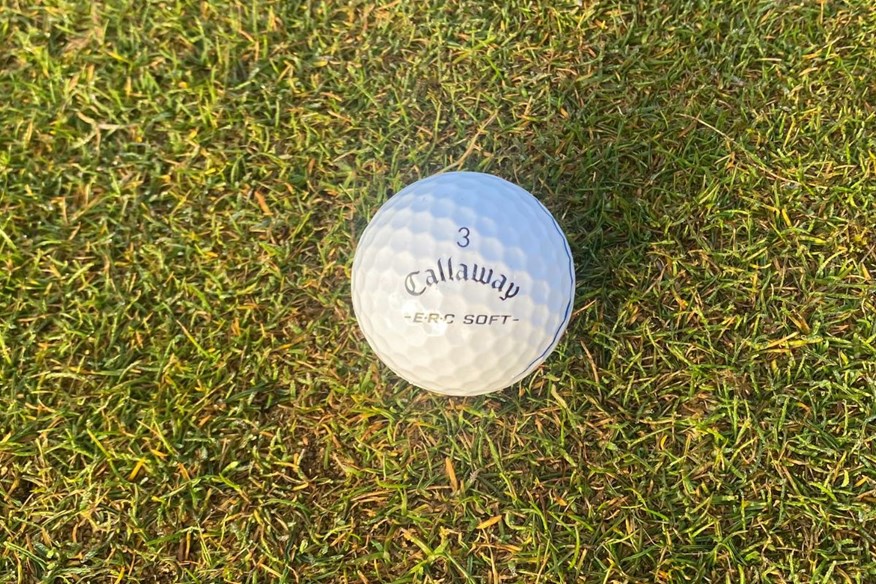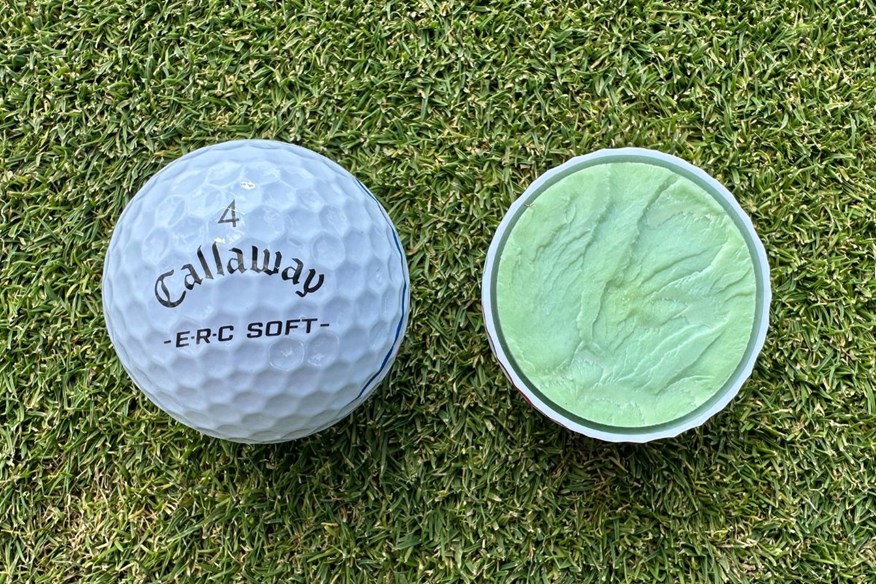Best golf balls for beginners and high handicappers 2025: Tested on-course and on an R&D robot
Last updated:
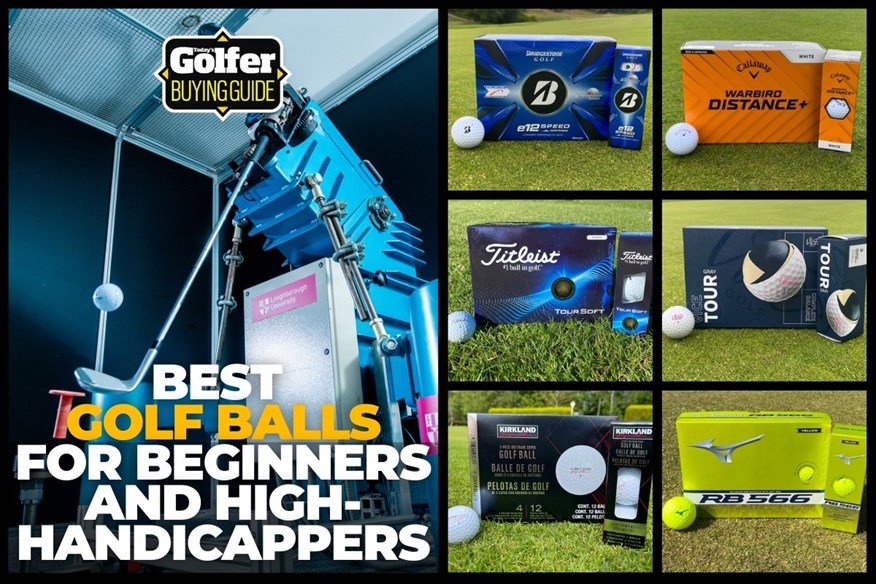
Click below to find out more about Today's Golfer's golf ball testing process.
We’ve tested the most popular and most-played golf balls on an R&D robot and on-course to help you determine which is the best golf ball for beginners and high-handicappers
Jump to:
- At a glance
- Best golf balls for beginners and high handicappers
- Robot test data
- Buying guide
- FAQs
- What to read next
If you are a beginner or high-handicap golfer, choosing the best golf ball to play with can be overwhelming because of the extensive choice. We’re here to help you make the right choice, so you can play better golf and find more enjoyment.
Every manufacturer produces quality golf balls to suit different golfers, and we’ve tested 62 models on an R&D robot to help you determine which is best for your game. Click the links below to see how we completed this year’s robot test and to find out exactly how we test golf equipment.
- 2025 golf ball robot test: 62 golf balls, 2,232 shots, 50,000 data points… find out what’s No.1 for you
- How we test golf equipment at Today’s Golfer
Each ball aimed at beginners and high handicappers slightly differs in performance and technology. Some balls feel softer or firmer than others. Also, some balls are designed to maximize distance, whereas others are intended to maximize spin and control. Although distance might not be as prominent once the golf ball rollback starts to impact the balls you can buy on the shelves!
The best golf balls for beginners and high handicappers 2025: At a glance
As a beginner or high-handicap golfer, it doesn’t mean you have to play with golf balls tailored to your playing ability. If you want to play with a ball packed with more technology or with a urethane cover, then you want to consider the best premium golf balls, which do come at a greater cost.
Regardless of whether you are looking for the best golf balls for distance or any other type of golf balls, what we want to ensure is you are finding the best value golf balls for your game.
To help you choose, we have compiled a list of the best golf balls for beginners and high handicappers.
Best golf balls for beginners and high handicappers
Gold medal for tee to green performance at all three driver swing speeds, off-the-tee performance, and approach play performance
Let's start by running through all of the e12 Speed's awards. Gold medal for tee to green performance at 114mph, 93mph, and 78mph, off-the-tee performance, and approach play performance.
The only area where the e12 Speed didn't rank is short game performance, where it finished in fourth, by 9rpm (5,951).
The e12 Speed is the highest-performing Bridgestone golf ball, factoring in how it performed in every area. Its best performance has to be off the tee. At 114mph, this golf ball was 2.4 yards longer and 0.8mph faster than the second-longest and second-fastest model, and fourth-longest overall (273.9yds).
At 93mph, the e12 Speed is the second longest (209.7yds) and fastest (134.1mph) 2-piece golf ball. But, at 78mph, this golf ball is back at the top of the table for both (161.3yds and 113.2mph).
Combine that performance with its dominating approach play performance, and not only do you have an amazing golf ball off the tee, but you have a fantastic golf ball from tee to green.
The e12 Speed is a golf ball I urge every golfer to consider. This is hands down the best value golf ball in the entire test, and as one of the best performers of all 62 models tested, what harm do you have in giving it a go?
On-course verdict
I was extremely surprised by the on-course performance of the Bridgestone e12 Speed, and having played with this golf ball on a couple of occasions, it has never disappointed.
The first time I played with the e12 Speed had me questioning if it definitely is a two-piece golf ball because it performs much closer to other three-piece Tour-level models.
The Bridgestone golf ball I' like most'm most fond of is the Tour B XS, and I think this performs very similarly - if not better.
The feel is slightly firmer than the Tour B XS, which is something I appreciate, and it does deliver more feedback and response throughout the bag.
Overall, I'm very impressed with the tee to green performance of the e12 Speed. Despite being a two-piece model, I wouldn't be quick to dismiss it.
Pros
- Perfroms more like a premium golf ball
- Outstanding tee to green performance
- Amazing feedback and response
Cons
- Very difficult to criticize
| Carry distance (yds) | Driver 114mph - 273.9 | Driver 93mph - 210 | Driver 78mph - 161.3 | 7-iron - 157.6 |
| Ball speed (mph) | Driver 114mph - 164 | Driver 93mph - 134.1 | Driver 78mph - 113.2 | 7-iron - 109.2 |
| Backspin (rpm) | Driver 114mph - 2,680 | Driver 93mph - 2,574 | Driver 78mph - 2,317 | 7-iron - 4,467 | Pitch - 5,951 |
| Launch angle (°) | Driver 114mph - 11.4 | Driver 93mph - 12.9 | Driver 78mph - 14.1 | 7-iron - 21.3 | Pitch - 30.7 |
| Descent angle (°) | Driver 114mph - 37.6 | Driver 93mph - 31.8 | Driver 78mph - 27 | 7-iron - 45.1 | Pitch - 36 |
| Peak height (yds) | Driver 114mph - 33 | Driver 93mph - 22.3 | Driver 78mph - 15.5 | 7-iron - 30 | Pitch - 6.9 |
| Compression (psi) | 103 |
- Optimal Flight System
- Fast gradational core
- MindSet technology
- 330 dimples
- 2-Piece construction
- Available in white only
Silver medal for tee to green performance at 93mph and 78mph and short game performance
The Warbird Distance+ is Callaway's cheapest golf ball, but it certainly doesn't perform as though it is. This model scooped up the second-most awards in the two-piece category.
Tee to green performance is incredibly strong at all three swing speeds. The Warbird Distance+ won silver at 93mph and 78mph, and bronze at 114mph. Distance is definitely a strong factor, being the third-best golf ball off the tee in this category.
However, this golf ball isn't purely a distance model (despite it being in its name). For short game performance, the Warbird Distance+ is the second-highest-spinning two-piece model (5,963rpm) and the third-highest-spinning Callaway golf ball.
We're really impressed by the overall performance of the Warbird Distance+. It's firmly put this golf ball on our radar, and with its test results, it should be for you, too!
On-course verdict
I didn't have particularly high hopes for the Callaway Warbird Distance+ given its price, construction, and name, but I'm happy to have been proven wrong.
The Warbird Distance+ doesn't feel the greatest. It's slightly clicky and clunky, which doesn't make the feedback and response very pleasant, but if you can look past that, this is a solid golf ball from tee to green.
Despite being a distance golf ball, the Warbird Distance+ offers much more than solely distance. This golf ball produces high-spin when attacking pins with an iron and wedge - something you don't always expect from a distance golf ball, but it's always appreciated.
Although the Warbird Distance+ offers more than distance, distance is very impressive with this model, thanks to the reduced spin. The carry distance is long, but the ball continues to roll a long way, delivering amazing total distance.
The Warbird Distance+ might not jump out as a must-have golf ball, but you won't be disappointed if you give it a go - I most certainly wasn't.
Pros
- Solid tee to green performance
- Surprisingly strong short-game performance
- Impressive distance
Cons
- Not the nicest feel
| Carry distance (yds) | Driver 114mph - 270.9 | Driver 93mph - 209.2 | Driver 78mph - 161.3 | 7-iron - 157.9 |
| Ball speed (mph) | Driver 114mph - 163 | Driver 93mph - 133.7 | Driver 78mph - 113 | 7-iron - 108.7 |
| Backspin (rpm) | Driver 114mph - 2,683 | Driver 93mph - 2,611 | Driver 78mph - 2,346 | 7-iron - 4,273 | Pitch - 5,963 |
| Launch angle (°) | Driver 114mph - 11.1 | Driver 93mph - 13 | Driver 78mph - 14.2 | 7-iron - 21.6 | Pitch - 30.7 |
| Descent angle (°) | Driver 114mph - 36.8 | Driver 93mph - 32.2 | Driver 78mph - 27.3 | 7-iron - 44.9 | Pitch - 36.1 |
| Peak height (yds) | Driver 114mph - 31.7 | Driver 93mph - 22.5 | Driver 78mph - 15.6 | 7-iron - 29.9 | Pitch - 6.9 |
| Compression (psi) | 92 |
- Extra-large, high-energy core
- Hex aerodynamics
- 332 dimples
- 2-Piece construction
- Available in white and yellow
Gold medal for short game performance
Best Titleist golf ball for beginners and high-handicappers


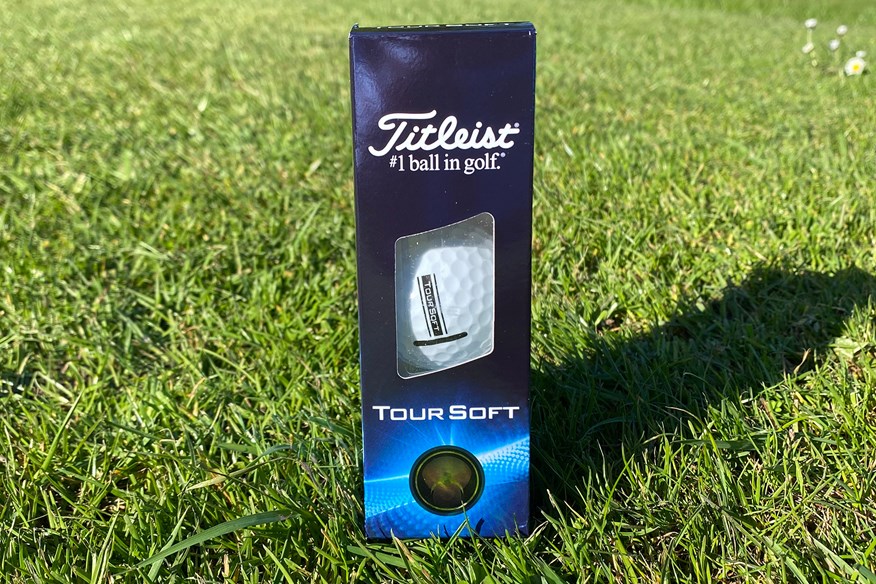
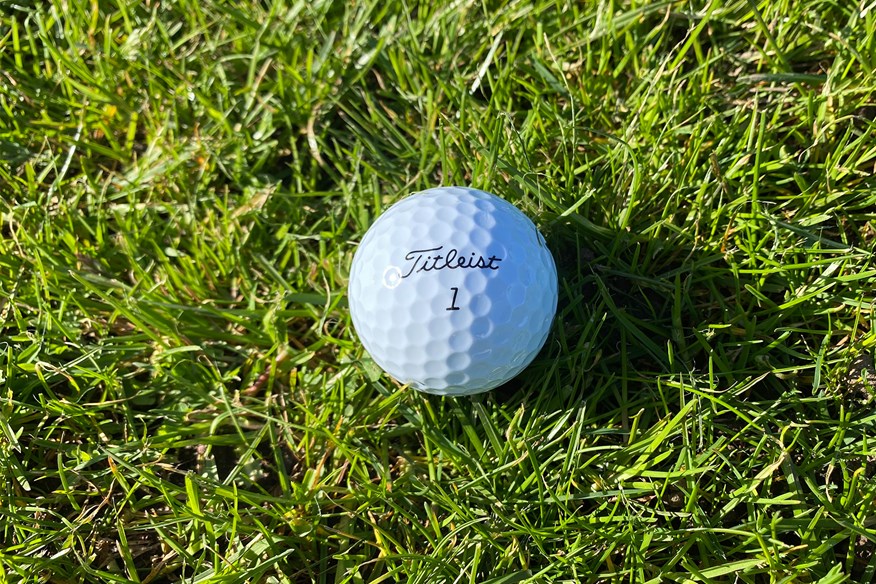
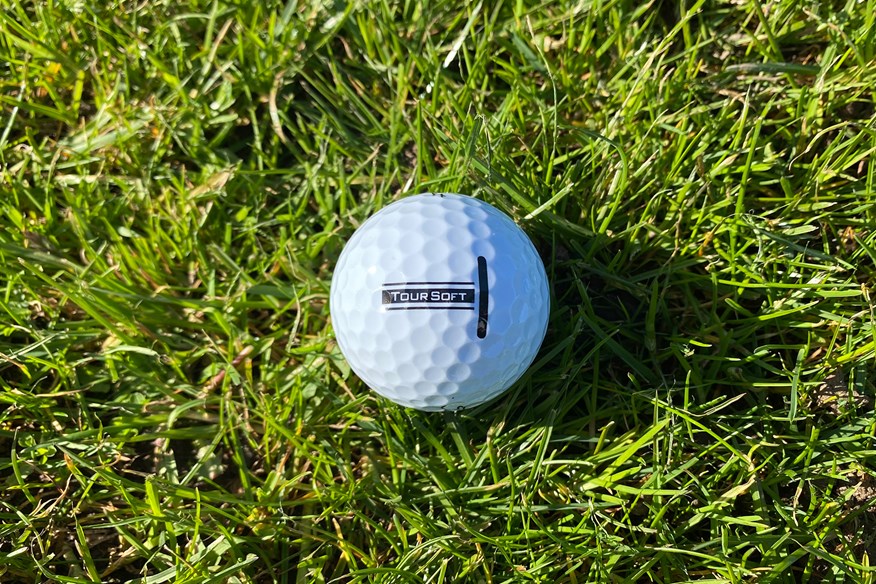
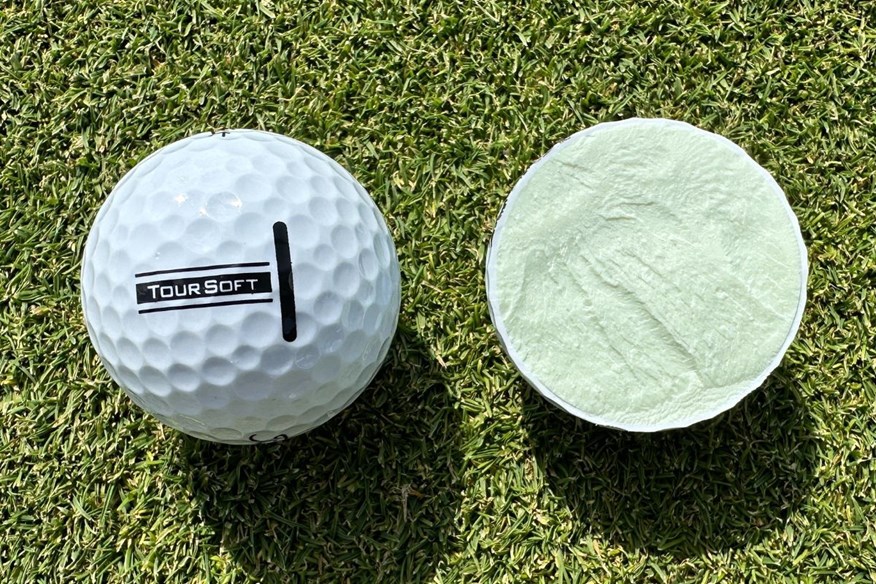
Moving to approach play, this golf ball is the bronze medal winner in this area. Tour Soft produces the second-highest spin (4,774rpm) and second-steepest descent angle (45.2), but it is the shortest two-piece golf ball (154.2yds).
Off-the-tee performance has this golf ball very closely matched with Titleist's distance two-piece golf ball - Velocity. Granted, Tour Soft is slightly shorter and slower at all three swing speeds. However, giving up less than a yard off the tee at every swing speed is probably worth it for the approach play and short game performance gains. It performed well enough at 114mph to earn the silver medal for tee to green performance.
Tour Soft is a super consistent golf ball in every area. If you're looking for a two-piece golf ball that'll do everything, this golf ball needs to be on your mind.
On-course verdict
This is one of the best-feeling golf balls I've had the pleasure of playing with purely because of how soft it is. I'm not always a fan of soft golf balls, but when they feel as good as the Tour Soft does, there's nothing to dislike.
The feedback and response throughout the bag is exactly what you want with a soft golf ball, but it's most enjoyable when playing around the greens because you can really feel the ball interacting with the grooves.
Around the greens, this ball generates amazing spin and control that's capable of challenging the best high-spin golf balls.
Moving away from the green, I didn't notice anything special about the Tour Soft's performance, but in the same breath, there's nothing to criticize. If anything, this ball performs better than you would expect from a two-piece model.
The Titleist Tour Soft is great value, and if you want a soft-feeling golf ball, this is the model you want.
Pros
- Amazing short-game spin and control
- Incredibly soft and responsive
- Great value
Cons
- Short distance in iron play
| Carry distance (yds) | Driver 114mph - 271.3 | Driver 93mph - 208.5 | Driver 78mph - 160.4 | 7-iron - 154.2 |
| Ball speed (mph) | Driver 114mph - 163.3 | Driver 93mph - 133.4 | Driver 78mph - 112.8 | 7-iron - 108.3 |
| Backspin (rpm) | Driver 114mph - 2,776 | Driver 93mph - 2,731 | Driver 78mph - 2,438 | 7-iron - 4,774 | Pitch - 6,075 |
| Launch angle (°) | Driver 114mph - 11.1 | Driver 93mph - 13 | Driver 78mph - 14 | 7-iron - 21.1 | Pitch - 30.4 |
| Descent angle (°) | Driver 114mph - 37.6 | Driver 93mph - 32.8 | Driver 78mph - 27.3 | 7-iron - 45.2 | Pitch - 35.7 |
| Peak height (yds) | Driver 114mph - 32.6 | Driver 93mph - 22.8 | Driver 78mph - 15.4 | 7-iron - 29.5 | Pitch - 6.8 |
| Compression (psi) | 95 |
- Large, faster core
- Reformulated thin fusablend cover
- Proprietary quadrilateral dipyramid dimple design
- 346 dimples
- 2-Piece construction
- Available in white, green, and yellow
- An alternative model is AIM 360
No.1 3-piece club golfer model
This is one of my most highly anticipated golf balls of the entire test. Ever since I tested the Vice Tour on-course, I've been waiting to see how it would perform in our robot test. I'm very pleasantly surprised.
I'm a fan of the Tour, but I never expected this golf ball would scoop up five awards in the three-piece club golfer category. As well as being the best golf ball for tee to green performance at 114mph, the Tour won the silver medal for tee to green performance at 93mph, off-the-tee performance, and short game performance, plus the bronze medal for tee to green performance at 78mph.
This golf ball is the real deal - and it doesn't have a urethane cover. That's quite possibly a reason as to why it's low-spinning when approaching greens (4,216rpm). However, around the greens, that spin shoots up, and it's the second-highest-spinning model with 5,967rpm (14th overall).
Short game and approach play performance is very clearly solid, but off the tee is where the Tour really gets you excited. At 114mph, this is the longest (271.4yds) and second-fastest (163.3mph) golf ball, at 93mph, it's the longest (208.3yds) and third-fastest (133.4mph), and at 78mph, it's the second-longest (160.8yds) and second-fastest (113.2mph).
There's a ton to like about the Vice Tour, and factoring in the price, as well as its domination, this is the best three-piece club golfer model.
On-course verdict
I would say the Vice Tour is a suitable option for a wide range of golfers because, as a whole, it’s a decent, well-rounded golf ball.
One area where the Vice Tour impresses me is with how well it propels off the face of a long iron. Distance is strong even into the wind, and there’s a more pleasant feedback from this ball than I feel from any of the golf balls in Vice’s Pro range.
I wouldn’t go as far as to say the Vice Tour is a soft-feeling golf ball or a firm-feeling golf ball. I would place it somewhere in the middle, with a medium feel.
Having played with Vice’s Pro Plus, Pro, and Pro Air golf balls, I would say that this golf ball is more responsive than all of those. The feel off the face isn’t as profound as other golf balls I’ve played with, but it definitely isn’t as muted as other Vice golf balls.
This helps to provide more feedback from your shot, which is something I like, but it isn’t something that every golfer wants. The responsiveness of the Vice Tour could be better, but for a golf ball with a Surlyn cover, it’s pretty good.
Whether you have a fast swing speed or a slow swing speed, the Vice Tour should definitely be on your radar.
Read our full Vice Tour golf ball review.
Pros
- Consistent and tight dispersion
- Impressive on-course distance
- Incredible value for money
Cons
- Not much grab on short approach shots
| Carry distance (yds) | Driver 114mph - 271.4 | Driver 93mph - 208.3 | Driver 78mph - 160.8 | 7-iron - 158.1 |
| Ball speed (mph) | Driver 114mph - 163.3 | Driver 93mph - 133.4 | Driver 78mph - 113 | 7-iron - 108.7 |
| Backspin (rpm) | Driver 114mph - 2,769 | Driver 93mph - 2,635 | Driver 78mph - 2,381 | 7-iron - 4,216 | Pitch - 5,967 |
| Launch angle (°) | Driver 114mph - 11.1 | Driver 93mph - 13 | Driver 78mph - 14 | 7-iron - 21.5 | Pitch - 30.6 |
| Descent angle (°) | Driver 114mph - 37.7 | Driver 93mph - 32.2 | Driver 78mph - 27.3 | 7-iron - 44.6 | Pitch - 35.8 |
| Peak height (yds) | Driver 114mph - 32.6 | Driver 93mph - 22.4 | Driver 78mph - 15.5 | 7-iron - 29.6 | Pitch - 6.7 |
| Compression (psi) | 112 |
- Enhanced mid-acid Surlyn cover
- High resilience and low stiffness composition
- Size-optimized High Energy Speed Core (HESC)
- 312 dimples
- 3-Piece construction
- Available in white and grey
Gold medal for short game performance
Kirkland golf balls are known for being high-spinning. The V2.0 was, and so is the V3.0. That's not an issue if you struggle to get the ball in the air or find it difficult to hit and hold greens. It also means the Signature V3.0 is amazing around the greens.
The Signature V3.0 is the gold medal winner for short game performance, in this category, generating 6,050rpm. Of all 62 golf balls tested, it's the seventh-highest-spinning golf ball.
Spin persists throughout the bag, and with the 7-iron shot, the Signature V3.0 is once again the highest-spinning three-piece club golfer model (4,861rpm). It also lands with the steepest descent angle (45°).
You might think the high-spinning nature will hurt how the V3.0 performs off the tee, but is that the case? Definitely not. The V3.0 is the bronze medal winner for off-the-tee performance.
It does generate a lot of spin, but it's also long and fast at all three swing speeds. At the fastest swing speed, it's the third-longest (271yds) and fastest (163.5mph), at the moderate swing speed, it's the third-longest (208yds) and fastest (133.6mph), and at the slower swing speed, it's the third-longest and fourth-fastest (112.8mph).
With the Kirkland Signature V3.0, you are signing yourself up to play with a high-spin golf ball, but if you need spin, it's one of the best models you can play with.
On-course verdict
Over the years, these golf balls have been highly regarded by many golfers and heavily scrutinized by others. Kirkland’s Signature three-piece golf balls are known for delivering high spin, and this is no different with their V3.0, as it ranks among the best high-spin golf balls.
The biggest issue the V3.0 has is that its spin compromises distance, but for some golfers, that won’t be an issue whatsoever.
When I took this ball out on the course, I couldn’t criticize its distance in the long game, but then again, high-spin golf balls suit my game.
I’m a big believer that for the majority of golfers, spin is your friend. You’re guaranteed a golf ball that easily generates spin by playing with the V3.0. Therefore, I believe that more golfers would benefit from playing with this golf ball than not playing with this golf ball.
I’m not normally a fan of soft-feeling golf balls, but I must say that the V3.0 feels good off the club face. I wouldn’t say that the response from this golf ball is particularly strong throughout the bag, but around the greens, there is a pleasant sensation when you clip the ball cleanly – something I think most golfers appreciate.
I think the Kirkland Signature V3.0 is a very strong golf ball. I would never expect to see it played on Tour, but for amateur golfers, it’s definitely one to consider. If you struggle to generate spin or if you just enjoy having a high-spinning golf ball, then it’s a fantastic option.
Read our full Kirkland Signature V3.0 golf ball review.
Pros
- Amazing price per ball considering the quality
- Combines soft feel, long distance, and high spin
- Impressive consistent ball flight
Cons
- Don't expect optimal carry distance
| Carry distance (yds) | Driver 114mph - 271 | Driver 93mph - 208 | Driver 78mph - 160.5 | 7-iron - 154.3 |
| Ball speed (mph) | Driver 114mph - 163.5 | Driver 93mph - 133.6 | Driver 78mph - 112.8 | 7-iron - 108.6 |
| Backspin (rpm) | Driver 114mph - 2,873 | Driver 93mph - 2,734 | Driver 78mph - 2,572 | 7-iron - 4,861 | Pitch - 6,050 |
| Launch angle (°) | Driver 114mph - 11.1 | Driver 93mph - 12.7 | Driver 78mph - 13.9 | 7-iron - 20.7 | Pitch - 30 |
| Descent angle (°) | Driver 114mph - 38.3 | Driver 93mph - 32.3 | Driver 78mph - 27.7 | 7-iron - 45 | Pitch - 35.1 |
| Peak height (yds) | Driver 114mph - 33.2 | Driver 93mph - 22.3 | Driver 78mph - 15.6 | 7-iron - 29.1 | Pitch - 6.5 |
| Compression (psi) | 107 |
- Increased core size
- Mantle with new proprietary cover
- Proprietary TPU with improved scuff resistance and impact endurance
- Modified dimple depth for optimized flight height
- 338 dimples
- 3-Piece construction
- Available in white only
Bronze medal for short game performance
Best Mizuno golf ball for short-game performance
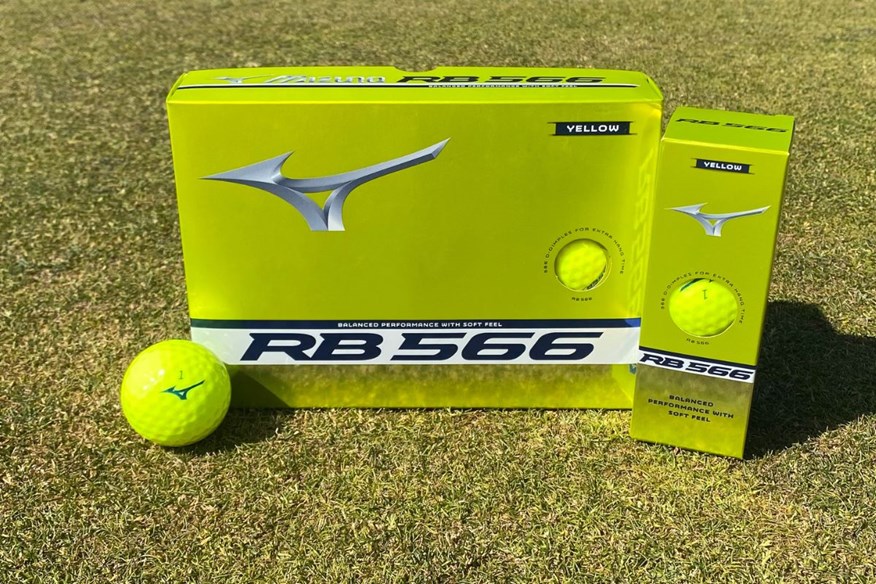

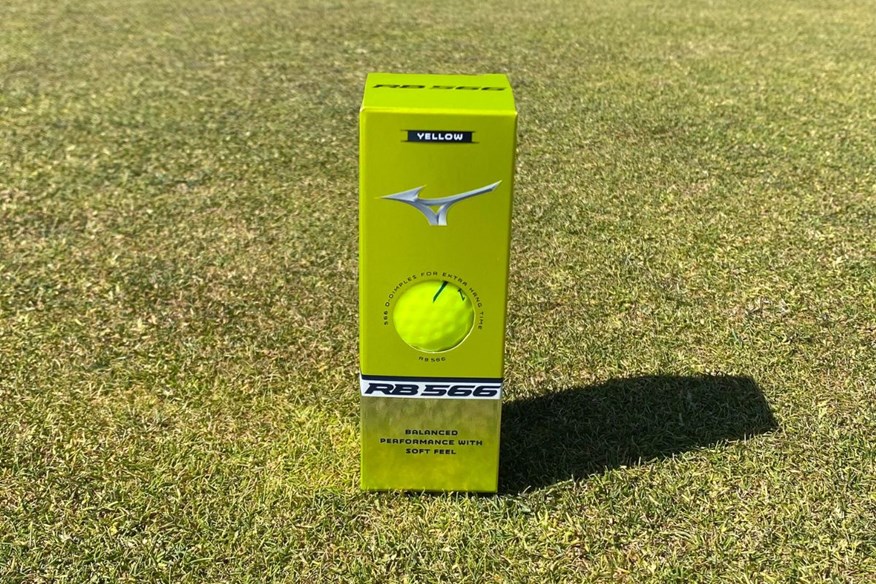
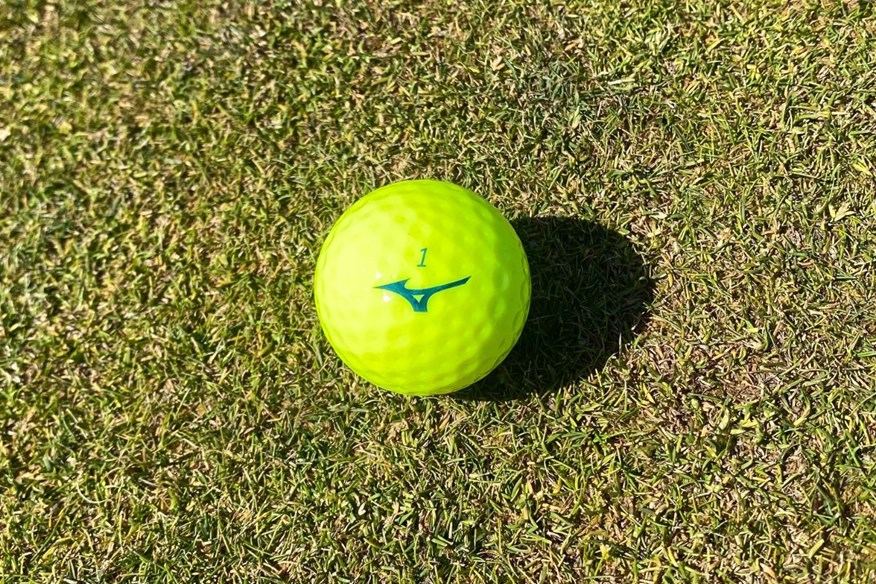
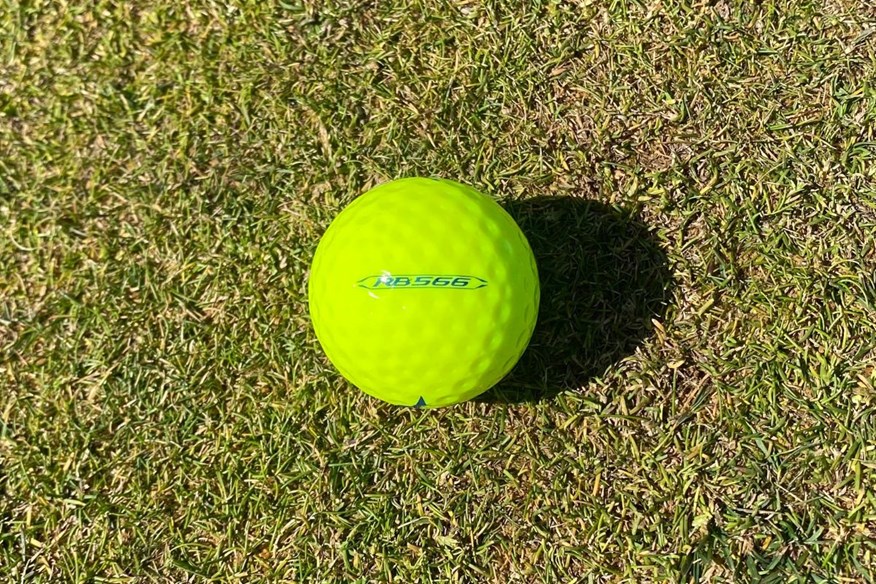
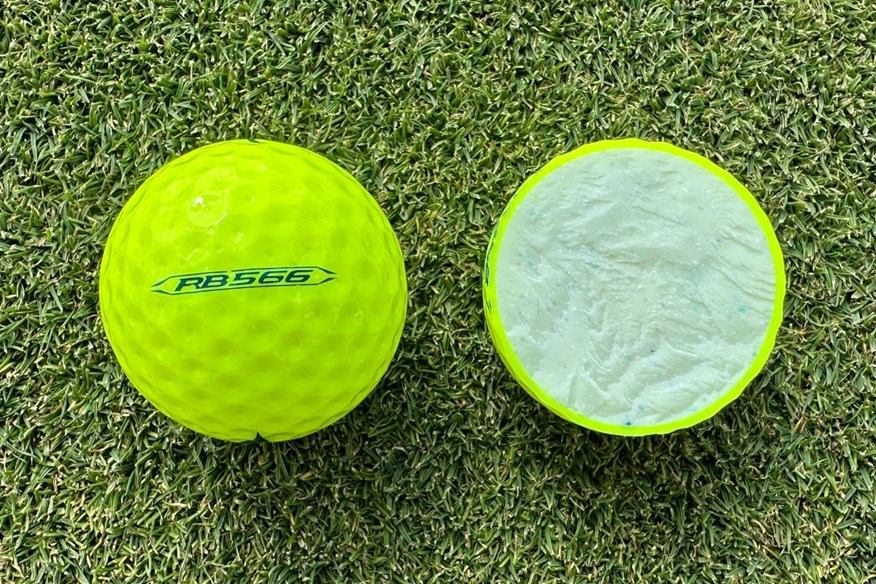
Probably not. However, it is the bronze medal winner for short game performance (5,960rpm). Although the dimple technology isn't specifically designed to generate spin, the RB 566 is the highest-spinning golf ball in approach play (4,947), and it lands with the steepest descent angle (45.3°).
Off the tee is where the RB 566 should make the most impact by reducing spin. It's below the test average for backspin at 93mph and 78mph, and bang on the average at 114mph. This makes it a very average performer for off-the-tee performance.
It might not be what Mizuno are going for, but I'd recommend the RB 566 for anyone looking for a high-spin golf ball. It's definitely a unique golf ball, and for that reason, it is interesting. However, the RB 566 should only tempt you if you're looking to add spin to your game.
On-course verdict
There's something very exciting about a unique golf ball, and so that's exactly how I felt when testing the Mizuno RB 566 with its 566 dimples.
I didn't really know what to expect from this golf ball, but I definitely wasn't expecting it to confuse me as much as it did. I had a lot of enjoyment playing with the RB 566 because I was able to throw the ball at the pin and watch it stop. I wasn't expecting it to spin as much as it did.
This golf ball was high-spinning for me throughout the bag. Off the tee, I was struggling to stop the ball from spinning. I definitely had contrasting emotions off the tee to approaching the green.
The feel is soft, and it's not the most responsive, which I'm not massively keen on.
Overall, I feel as though this is a high-spinning golf ball, almost to its detriment because it balloons off the tee. However, a different golfer might think otherwise, especially if you have a slower swing speed.
Pros
- Great short-game spin and control
- Good value
- Solid performance from tee to green
Cons
- Struggled to reduce spin off the tee on the course
| Carry distance (yds) | Driver 114mph - 268.6 | Driver 93mph - 207.9 | Driver 78mph - 160.2 | 7-iron - 154.8 |
| Ball speed (mph) | Driver 114mph - 161.9 | Driver 93mph - 133.3 | Driver 78mph - 112.6 | 7-iron - 109.1 |
| Backspin (rpm) | Driver 114mph - 2,719 | Driver 93mph - 2,553 | Driver 78mph - 2,381 | 7-iron - 4,947 | Pitch - 5,960 |
| Launch angle (°) | Driver 114mph - 11.1 | Driver 93mph - 13 | Driver 78mph - 14.1 | 7-iron - 20.7 | Pitch - 30.6 |
| Descent angle (°) | Driver 114mph - 36.9 | Driver 93mph - 31.6 | Driver 78mph - 27.2 | 7-iron - 45.3 | Pitch - 36 |
| Peak height (yds) | Driver 114mph - 31.5 | Driver 93mph - 21.9 | Driver 78mph - 15.4 | 7-iron - 29.6 | Pitch - 7 |
| Compression (psi) | 92 |
- Large soft compression core
- Micro dimple design
- Ionomer cover
- 566 dimples
- 2-Piece construction
- Available in white, yellow, and orange
Bronze medal for short game performance
Best Mizuno golf ball for beginners and high-handicappers






Probably not. However, it is the bronze medal winner for short game performance (5,960rpm). Although the dimple technology isn't specifically designed to generate spin, the RB 566 is the highest-spinning golf ball in approach play (4,947), and it lands with the steepest descent angle (45.3°).
Off the tee is where the RB 566 should make the most impact by reducing spin. It's below the test average for backspin at 93mph and 78mph, and bang on the average at 114mph. This makes it a very average performer for off-the-tee performance.
It might not be what Mizuno are going for, but I'd recommend the RB 566 for anyone looking for a high-spin golf ball. It's definitely a unique golf ball, and for that reason, it is interesting. However, the RB 566 should only tempt you if you're looking to add spin to your game.
On-course verdict
There's something very exciting about a unique golf ball, and so that's exactly how I felt when testing the Mizuno RB 566 with its 566 dimples.
I didn't really know what to expect from this golf ball, but I definitely wasn't expecting it to confuse me as much as it did. I had a lot of enjoyment playing with the RB 566 because I was able to throw the ball at the pin and watch it stop. I wasn't expecting it to spin as much as it did.
This golf ball was high-spinning for me throughout the bag. Off the tee, I was struggling to stop the ball from spinning. I definitely had contrasting emotions off the tee to approaching the green.
The feel is soft, and it's not the most responsive, which I'm not massively keen on.
Overall, I feel as though this is a high-spinning golf ball, almost to its detriment because it balloons off the tee. However, a different golfer might think otherwise, especially if you have a slower swing speed.
Pros
- Great short-game spin and control
- Good value
- Solid performance from tee to green
Cons
- Struggled to reduce spin off the tee on the course
| Carry distance (yds) | Driver 114mph - 268.6 | Driver 93mph - 207.9 | Driver 78mph - 160.2 | 7-iron - 154.8 |
| Ball speed (mph) | Driver 114mph - 161.9 | Driver 93mph - 133.3 | Driver 78mph - 112.6 | 7-iron - 109.1 |
| Backspin (rpm) | Driver 114mph - 2,719 | Driver 93mph - 2,553 | Driver 78mph - 2,381 | 7-iron - 4,947 | Pitch - 5,960 |
| Launch angle (°) | Driver 114mph - 11.1 | Driver 93mph - 13 | Driver 78mph - 14.1 | 7-iron - 20.7 | Pitch - 30.6 |
| Descent angle (°) | Driver 114mph - 36.9 | Driver 93mph - 31.6 | Driver 78mph - 27.2 | 7-iron - 45.3 | Pitch - 36 |
| Peak height (yds) | Driver 114mph - 31.5 | Driver 93mph - 21.9 | Driver 78mph - 15.4 | 7-iron - 29.6 | Pitch - 7 |
| Compression (psi) | 92 |
- Large soft compression core
- Micro dimple design
- Ionomer cover
- 566 dimples
- 2-Piece construction
- Available in white, yellow, and orange
Titleist's best 2-piece golf ball for off-the-tee performance
Best distance Titleist golf ball for beginners and high-handicappers
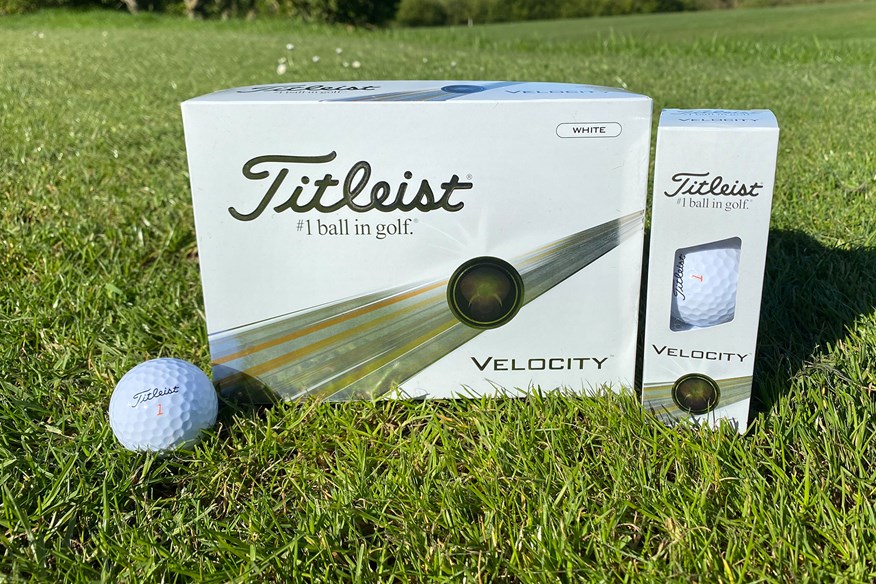


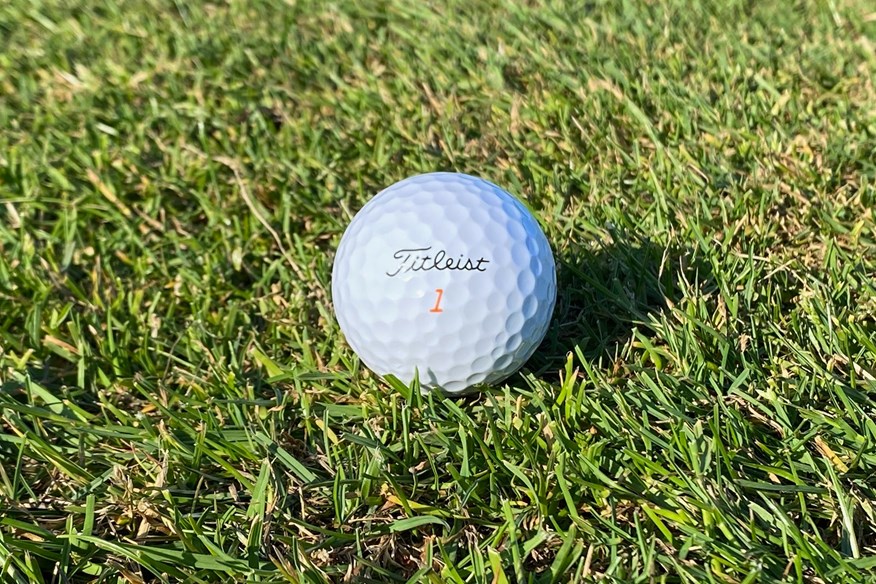
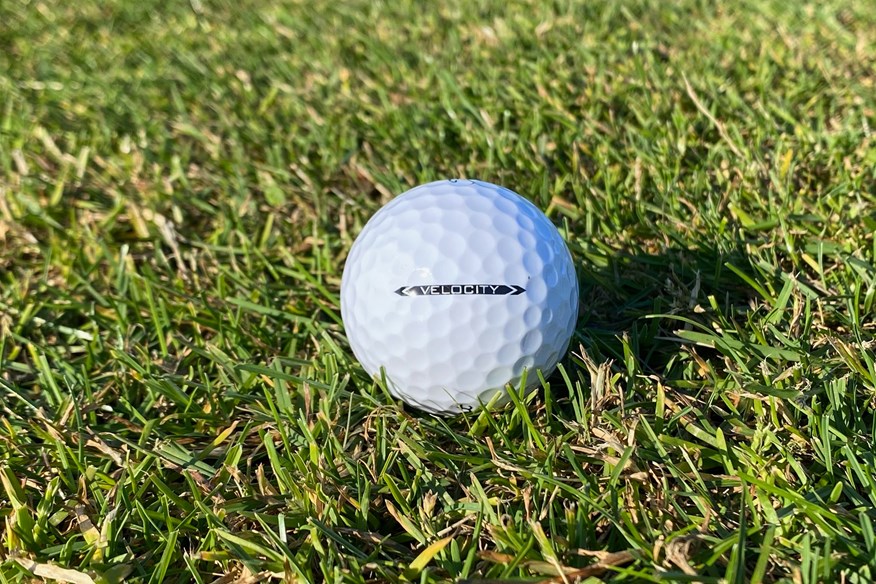
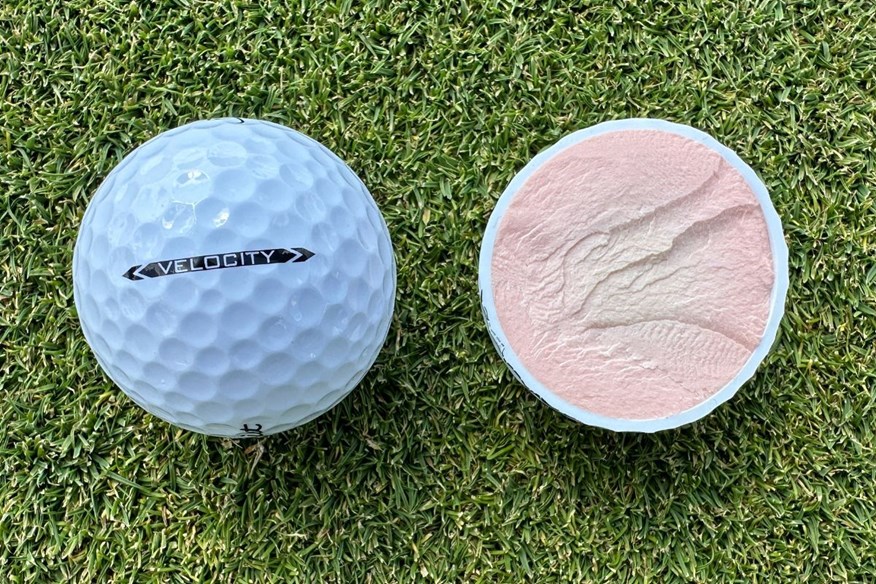
Across all three swing speeds, the Velocity is the fourth-best two-piece golf ball for overall performance off the tee. We fully expected the Velocity to perform well off the tee because it's a distance golf ball, but if we're being honest, we didn't expect it to outperform the four-piece Pro V1x.
The velocity delivered its best performance at 114mph. At the quickest swing speed we tested, the Velocity produced 271.5 carry yards and 163.2mph ball speed.
In approach play, the Velocity is the lowest-spinning golf ball (3,081rpm) and longest (160.6yds) out of all 62 models we tested. That's potentially expected given it's a distance golf ball.
However, the Velocity's short game performance is much better than we expected. This golf ball is the fifth-highest-spinning two-piece model, with 5,789rpm.
The Titleist Velocity delivers competitive distance and overall performance for all golfers. You're guaranteed distance, but you're also getting a golf ball that can perform around the greens.
On-course verdict
I'm quite the fan of Velocity. In the right hands, this can be a very strong performing golf ball. However, in the wrong hands, it can majorly hinder your game.
For my game, off the tee, Velocity performs very closely to the Pro V1x, but as I approach the green, distance begins to outweigh spin, which isn't something I require.
If you're a golfer who's looking to reduce spin and gain distance, Velocity has to be on your radar, especially at its price.
This is a two-piece golf ball, but I honestly think it's hard to tell. If I weren't able to distinguish this golf ball in Titleist's line-up by its orange numbers, I think you could trick me into thinking it's the Pro V1x based on its long game performance. Take it to the short-game area, and it's very easy to see this is a distance golf ball.
Pros
- Very competitive distance
- Great value
- Good feel and feedback
Cons
- Low short-game spin and control
| Carry distance (yds) | Driver 114mph - 271.5 | Driver 93mph - 208.9 | Driver 78mph - 160.6 | 7-iron - 160.6 |
| Ball speed (mph) | Driver 114mph - 163.2 | Driver 93mph - 133.5 | Driver 78mph - 112.9 | 7-iron - 108.7 |
| Backspin (rpm) | Driver 114mph - 2,677 | Driver 93mph - 2,467 | Driver 78mph - 2,261 | 7-iron - 3,801 | Pitch - 5,789 |
| Launch angle (°) | Driver 114mph - 11.1 | Driver 93mph - 13.2 | Driver 78mph - 14.2 | 7-iron - 21.9 | Pitch - 31.2 |
| Descent angle (°) | Driver 114mph - 36.9 | Driver 93mph - 31.5 | Driver 78mph - 26.8 | 7-iron - 44 | Pitch - 36.7 |
| Peak height (yds) | Driver 114mph - 31.8 | Driver 93mph - 22.2 | Driver 78mph - 15.3 | 7-iron - 29.6 | Pitch - 7.1 |
| Compression (psi) | 101 |
- High-speed LSX core
- Fast NAZ+ cover
- Spherically-tiled octahedral dimple pattern
- 350 dimples
- 2-Piece construction
- Available in white, green, and orange
Gold medal for tee to green performance at 93mph and approach play performance
Best Srixon golf ball for beginners and high-handicappers
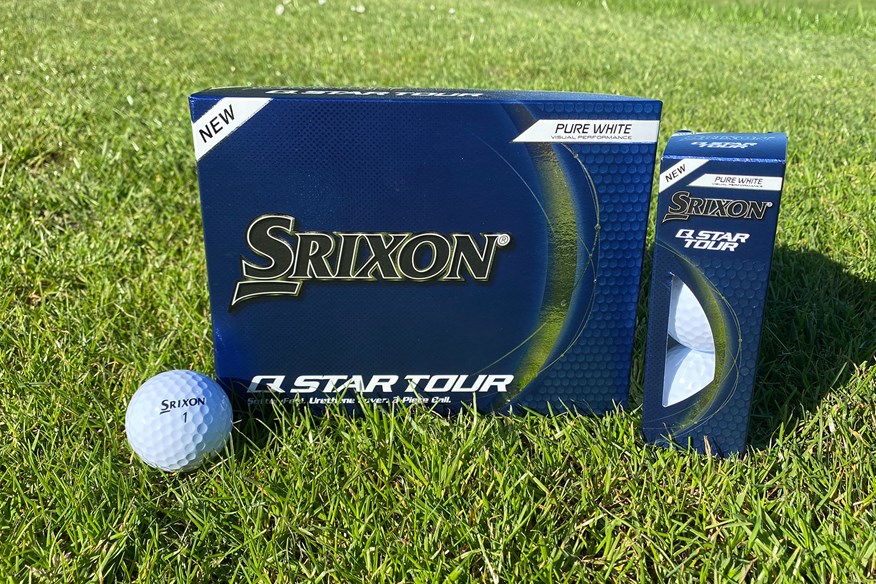

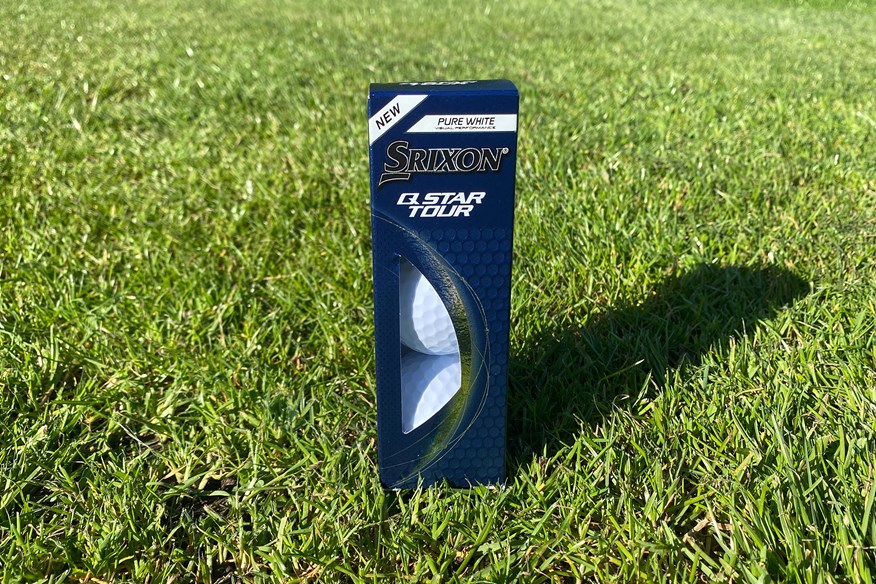
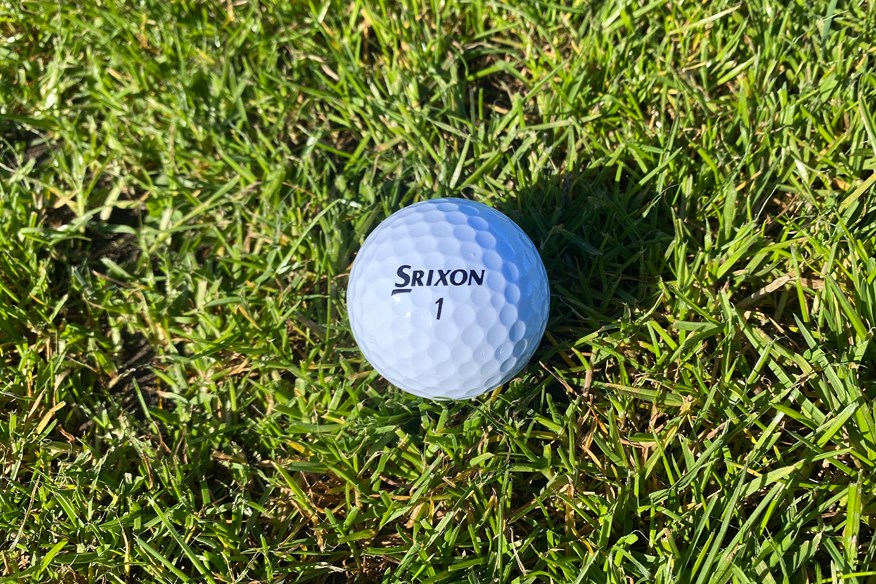
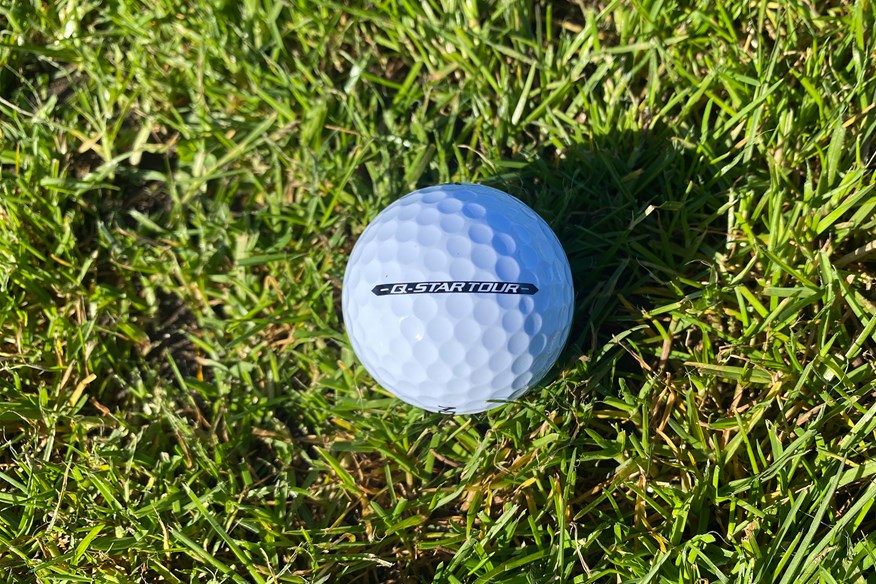
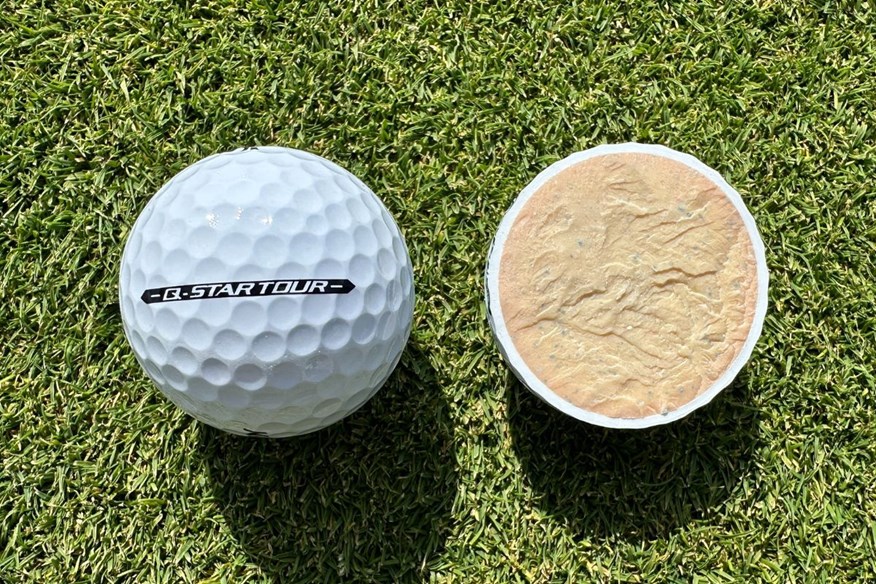
The Q-Star Tour is Srixon's bridging golf ball between the two-piece Q-Star and the three-piece Tour-level Z-Star series. The Q-star Tour features plenty of technology found in the Z-Star golf balls, but it just doesn't perform as well.
You'd probably expect that, given it's a cheaper model than all three Z-Star golf balls, but against other three-piece club golfer models, the Q-Star Tour is a brilliant option. This golf ball performs very well in its approach play, ranking best of all golf balls in this category, thanks to its steep descent angle (45°), impressive backspin (4,568), and incredible carry distance consistency - ranking 2nd overall.
The Q-Star Tour is the gold medal winner for approach play performance, and with how strong it is in the 7-iron shot, it helped it achieve the gold medal for tee to green performance at 93mph, and the silver medal at 114mph and 78mph.
You won't be blown away by the Q-Star Tour's performance off the tee, but it's strong enough to make this the overall best three-piece club golfer model for tee to green performance at all three swing speeds.
On-course verdict
The Q-star Tour is very easy to enjoy because it contains some technology found in the premium Z-Star range, but it's a fraction of the price.
Obviously, the Q-Star Tour's performance isn't as high as the three Z-Star golf balls, but it's a very strong performer for mid-handicappers wanting a solid golf ball from tee to green.
Someone I play golf with regularly often switches to the Q-Star Tour because of the fact you're getting close to premium performance, and it's not as gut-wrenching if you lose one.
If you're looking for distance, the Q-Star Tour might not be your first choice, but for control and spin, it's a very good option. What you lose in distance off the tee is definitely made up for with what you gain in spin and control when approaching greens.
Read our full Srixon Q-Star Tour golf ball review.
Pros
- Good performance from tee to green
- Impressive feel from every club in the bag
- Wind doesn't massively hamper distance
Cons
- Distance isn't its strong suit
| Carry distance (yds) | Driver 114mph - 267.4 | Driver 93mph - 205.5 | Driver 78mph - 160.5 | 7-iron - 155.6 |
| Ball speed (mph) | Driver 114mph - 161.8 | Driver 93mph - 132.6 | Driver 78mph - 112.8 | 7-iron - 108.4 |
| Backspin (rpm) | Driver 114mph - 2,828 | Driver 93mph - 2,720 | Driver 78mph - 2,428 | 7-iron - 4,568 | Pitch - 5,575 |
| Launch angle (°) | Driver 114mph - 11 | Driver 93mph - 12.7 | Driver 78mph - 14 | 7-iron - 21.2 | Pitch - 31.5 |
| Descent angle (°) | Driver 114mph - 37.4 | Driver 93mph - 31.9 | Driver 78mph - 27.4 | 7-iron - 45 | Pitch - 37.2 |
| Peak height (yds) | Driver 114mph - 31.9 | Driver 93mph - 21.8 | Driver 78mph - 15.5 | 7-iron - 29.5 | Pitch - 7.3 |
| Compression (psi) | 76 |
- FastLayer core
- Spin Skin coating
- Ultra-thin urethane cover
- Speed dimple pattern
- 338 dimples
- 3-Piece construction
- Available in white and yellow
- An alternative model is the Divide
Gold medal for tee to green performance at 78mph and off-the-tee performance
The Callaway ERC Soft outshines the Chrome Soft in the three-piece club golfer category, mainly due to its tee to green performance. The ERC Soft is the best golf ball in this category for tee to green performance at 78mph and the third-best at 93mph. Another award for this golf ball is the gold medal for off-the-tee performance.
This is a super strong golf ball off the tee - it's by far the best at 78mph with 161.4 carry yards and 113.2mph ball speed. At 93mph, it's right up there again, ranking first for carry distance (208.3yds) and second for ball speed (133.5mph). At 114mph, three golf balls blow the others away in this category, but the ERC Soft is best-of-the-rest (269.9yds and 162.5mph).
The biggest dip in performance for the ERC Soft is in approach play. This is the second-lowest spinning golf ball (4,154rpm) and has a 44.6° descent angle. That materialises into good distance (158.4yds), but that's not the focal point when playing into greens.
With short game performance, you can expect a golf ball that will grab and spin. The ERC Soft delivers strong spin numbers here with 5,592rpm - higher than the Chrome Soft.
The ERC Soft is one of the best three-piece club golfer models, and the fact it outshines the Chrome Soft draws serious, warranted attention.
On-course verdict
The Callaway ERC Soft is a golf ball I really enjoy playing with because it feels like a golf ball you can absolutely hammer, and it will behave. This golf ball's performance from tee to green is nothing to be snubbed at.
Off the tee, the ERC Soft travels well, with minimal long-game spin. For my game, this isn't optimal, but I imagine most golfers will appreciate this. Around the greens, it's a different story. The ERC Soft is easy to control and spin. However, I don't think it's as impressive as the previous generation.
This is a soft-feeling golf ball - as the name suggests - and I find it to be lacking in feedback and response because of how soft it is. You might think otherwise, but personally, I want a golf ball with a touch more feedback.
The ERC Soft is a fantastic golf ball from tee to green at a great price. I prefer this model over the Chrome Soft, although they are both fun golf balls.
Pros
- Very soft feel
- Good tee to green performance
- Impressive distance
Cons
- Lacks feedback and response
| Carry distance (yds) | Driver 114mph - 269.9 | Driver 93mph - 208.3 | Driver 78mph - 161.4 | 7-iron - 158.4 |
| Ball speed (mph) | Driver 114mph - 162.5 | Driver 93mph - 133.4 | Driver 78mph - 113.2 | 7-iron - 108.6 |
| Backspin (rpm) | Driver 114mph - 2,690 | Driver 93mph - 2,635 | Driver 78mph - 2,388 | 7-iron - 4,154 | Pitch - 5,592 |
| Launch angle (°) | Driver 114mph - 11.1 | Driver 93mph - 13 | Driver 78mph - 14 | 7-iron - 21.6 | Pitch - 31.4 |
| Descent angle (°) | Driver 114mph - 36.8 | Driver 93mph - 32.2 | Driver 78mph - 27.3 | 7-iron - 44.6 | Pitch - 37.1 |
| Peak height (yds) | Driver 114mph - 31.5 | Driver 93mph - 22.4 | Driver 78mph - 15.5 | 7-iron - 29.7 | Pitch - 7.3 |
| Compression (psi) | 87 |
- Hyper elastic SoftFast core
- Hybrid cover
- GRIP urethane coating
- High-speed mantle
- Advanced alignment from Triple Track technology
- 332 dimples
- 3-Piece construction
- Available in white and yellow
- Alternative models include Truvis and 360° Fade
Bridgestone's longest 3-piece golf ball
Best three-piece Bridgestone golf ball for beginners and high-handicappers
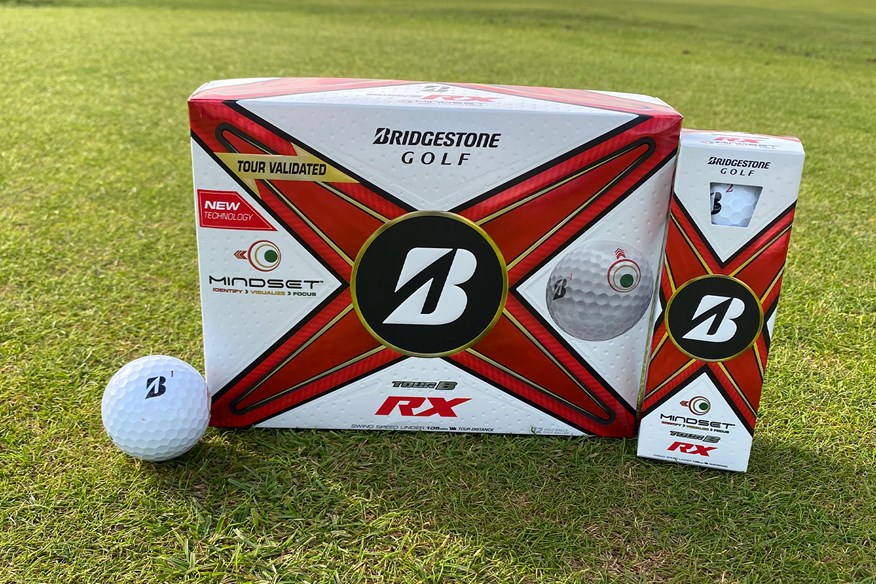

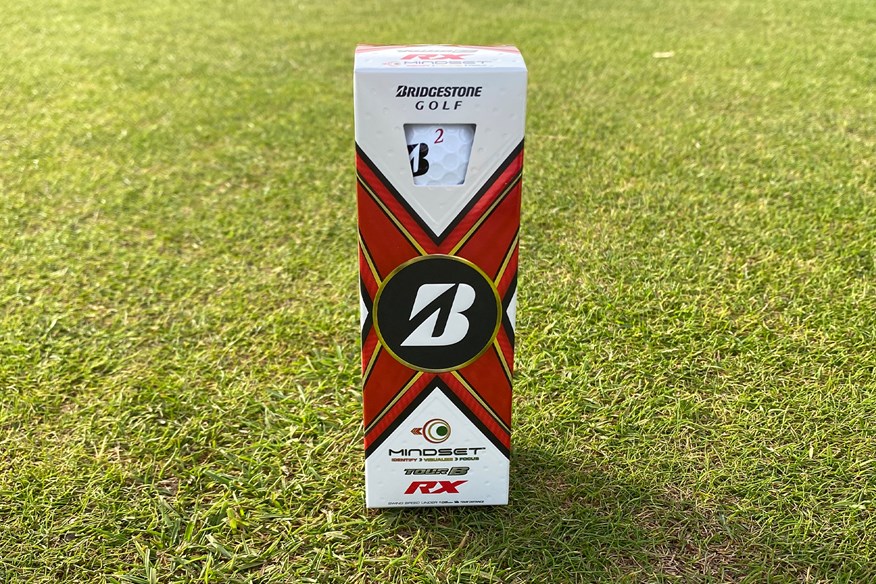

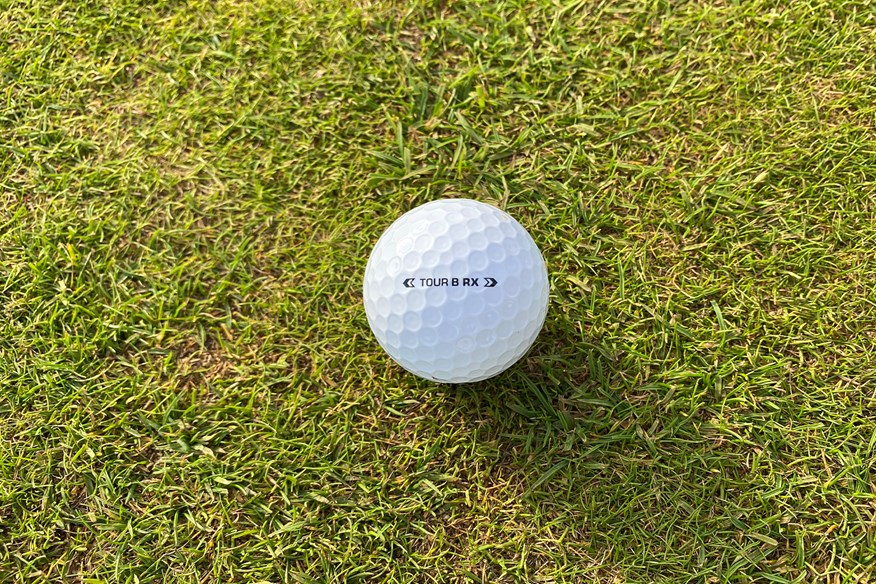
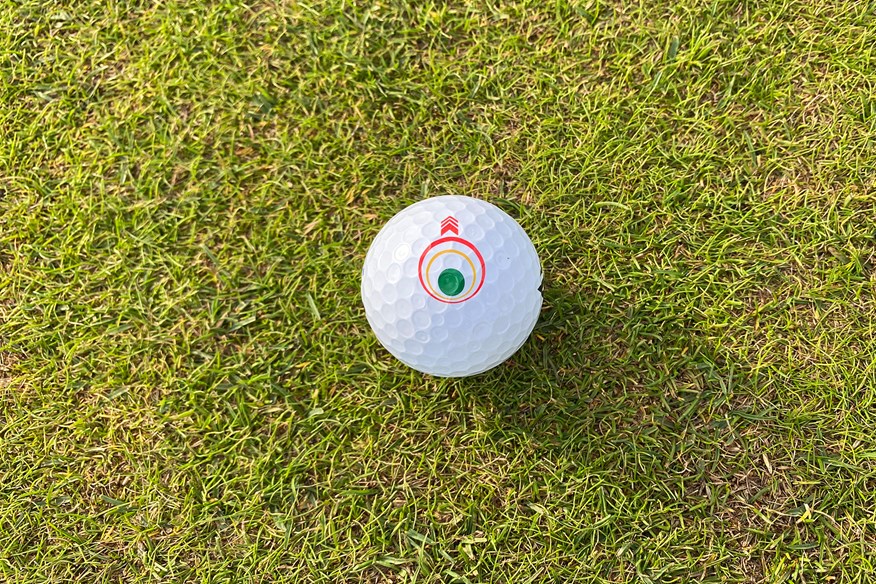
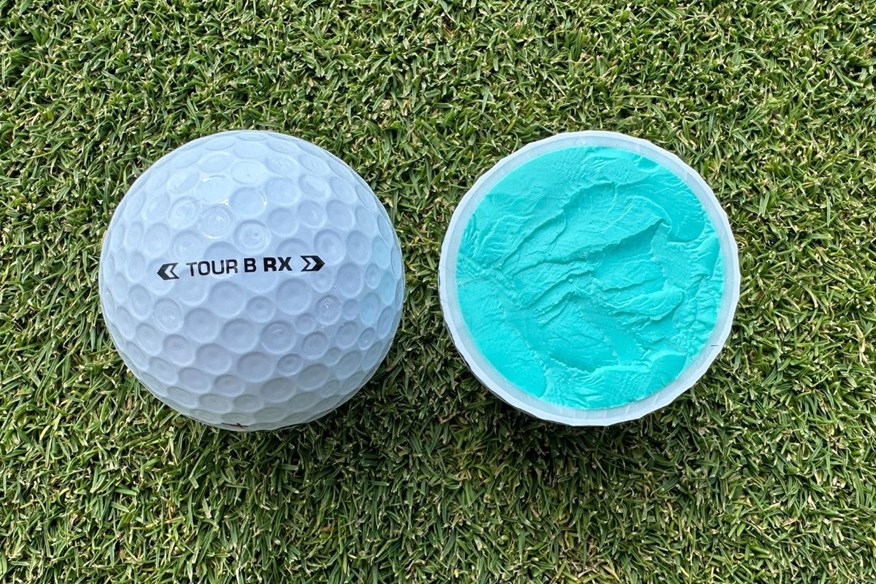
There isn't an awful lot to say about the Bridgestone Tour B RX golf ball other than out of the five three-piece Bridgestone golf balls, including the four members of the Tour B range, the Tour B RX is the longest golf ball, delivering 268.9 carry yards at the 114mph driver swing speed.
At 93mph and 78mph, the Tour B RX isn't as long as other three-piece club golfer models, nor is it as long as other three-piece Bridgestone golf balls. However, at both swing speeds, it is longer than the higher-spinning Tour B RXS.
Although the Tour B RX is sold as the more distance-oriented Tour B model for golfers who swing their driver below 95mph, it's not too far behind the Tour B RXS with regard to spin in approach play and short game performance. The Tour B RX generates 4,733rpm with the 7-iron and 5,645rpm with the 40-yard pitch shot. In both instances, it's within 100rpm of the higher-spinning Tour B RXS.
The Tour B RX is a solid golf ball, but it's not going to blow you away with its performance. You can expect all-around performance, with a slight emphasis on distance over spin.
On-course verdict
The Bridgestone Tour B RX isn't a golf ball I would consider playing with because it doesn't suit my game. For that reason, I trusted one of my playing partners to offer his verdict on this golf ball.
The Tour B RX is designed for golfers who swing their driver slower than 105mph and prioritize distance over spin. Thankfully, someone I regularly play golf with falls into that category.
He enjoyed the mindset technology most about this golf ball, which tells you how good that is, considering with this golf ball in play, he recorded two rounds of 75.
Distance was where he expected, and so was spin. He doesn't play with a lot of spin through choice, and this golf ball allowed him to continue chasing the ball up the fairway off the tee and towards the flag on the greens.
If you would benefit from more spin, depending on your swing speed, you'll want either the Tour B RXS or Tour B XS in play.
The Tour B RX is a model played on the Champions Tour but not on the PGA or DP World Tour, hence why it's more suited to club golfers with a swing speed south of 105mph.
If you're looking to maximize distance, the Tour B RX is a model well worth your consideration.
Pros
- Competitive distance
- Impressive spin and control
- Delivers on its promise
Cons
- Not the most exciting golf ball
| Carry distance (yds) | Driver 114mph - 268.9 | Driver 93mph - 206.5 | Driver 78mph - 160.4 | 7-iron - 155.4 |
| Ball speed (mph) | Driver 114mph - 161.8 | Driver 93mph - 133.1 | Driver 78mph - 112.9 | 7-iron - 108.8 |
| Backspin (rpm) | Driver 114mph - 2,732 | Driver 93mph - 2,780 | Driver 78mph - 2,532 | 7-iron - 4,733 | Pitch - 5,645 |
| Launch angle (°) | Driver 114mph - 11.3 | Driver 93mph - 12.6 | Driver 78mph - 13.8 | 7-iron - 20.7 | Pitch - 30.9 |
| Descent angle (°) | Driver 114mph - 37.4 | Driver 93mph - 32.2 | Driver 78mph - 27.5 | 7-iron - 44.9 | Pitch - 36.4 |
| Peak height (yds) | Driver 114mph - 32.3 | Driver 93mph - 22 | Driver 78mph - 15.4 | 7-iron - 29.2 | Pitch - 7 |
| Compression (psi) | 99 |
- REACTIV X System
- REACTIV iQ Smart Cover Technology
- XCLRNT mid-layer
- Gradational Core
- Dual Dimple
- Seamless Cover
- 330 dimples
- 3-Piece construction
- Available in white and yellow
- An alternative model is the Mindset
Best golf balls for beginners and high handicappers: Robot test data
View the full golf ball robot test results.
| Golf ball | Bridgestone e12 Speed | Callaway Warbird Distance+ | Titleist Tour Soft | Vice Tour | Kirkland Signature V3.0 | Mizuno RB 566 | Titleist Velocity | Srixon Q-Star Tour | Callaway ERC Soft | Bridgestone Tour B RX |
| Compression | 103 | 92 | 95 | 112 | 107 | 92 | 101 | 76 | 87 | 99 |
| 114mph Driver Ball Speed (mph) | 164.0 | 163.0 | 163.3 | 163.3 | 163.5 | 161.9 | 163.2 | 161.8 | 162.5 | 161.8 |
| 114mph Driver Launch Angle (°) | 11.4 | 11.1 | 11.1 | 11.1 | 11.1 | 11.1 | 11.1 | 11.0 | 11.1 | 11.3 |
| 114mph Driver Backspin (rpm) | 2680 | 2683 | 2776 | 2769 | 2873 | 2719 | 2677 | 2828 | 2690 | 2732 |
| 114mph Driver Carry Distance (yds) | 273.9 | 270.9 | 271.3 | 271.4 | 271.0 | 268.6 | 271.5 | 267.4 | 269.9 | 268.9 |
| 114mph Driver Height (yds) | 33.0 | 31.7 | 32.6 | 32.6 | 33.2 | 31.5 | 31.8 | 31.9 | 31.5 | 32.3 |
| 114mph Driver Descent Angle (°) | 37.6 | 36.8 | 37.6 | 37.7 | 38.3 | 36.9 | 36.9 | 37.4 | 36.8 | 37.4 |
| 93mph Driver Ball Speed (mph) | 134.1 | 133.7 | 133.4 | 133.4 | 133.6 | 133.3 | 133.5 | 132.6 | 133.5 | 133.1 |
| 93mph Driver Launch Angle (°) | 12.9 | 13.0 | 13.0 | 13.0 | 12.7 | 13.0 | 13.2 | 12.7 | 12.9 | 12.6 |
| 93mph Driver Backspin (rpm) | 2574 | 2611 | 2731 | 2635 | 2734 | 2553 | 2467 | 2720 | 2596 | 2780 |
| 93mph Driver Carry Distance (yds) | 209.7 | 209.2 | 208.5 | 208.3 | 208.0 | 207.9 | 208.9 | 205.5 | 208.3 | 206.5 |
| 93mph Driver Height (yds) | 22.3 | 22.5 | 22.8 | 22.4 | 22.3 | 21.9 | 22.2 | 21.8 | 22.2 | 22.0 |
| 93mph Driver Descent Angle (°) | 31.8 | 32.2 | 32.8 | 32.2 | 32.3 | 31.6 | 31.5 | 31.9 | 31.8 | 32.2 |
| 78mph Driver Ball Speed (mph) | 113.2 | 113.0 | 112.8 | 113.0 | 112.8 | 112.6 | 112.9 | 112.8 | 113.2 | 112.9 |
| 78mph Driver Launch Angle (°) | 14.1 | 14.2 | 14.0 | 14.0 | 13.9 | 14.1 | 14.2 | 14.0 | 14.0 | 13.8 |
| 78mph Driver Backspin (rpm) | 2317 | 2346 | 2438 | 2381 | 2572 | 2381 | 2261 | 2428 | 2388 | 2532 |
| 78mph Driver Carry Distance (yds) | 161.3 | 161.3 | 160.4 | 160.8 | 160.5 | 160.2 | 160.6 | 160.5 | 161.4 | 160.4 |
| 78mph Driver Height (yds) | 15.5 | 15.6 | 15.4 | 15.4 | 15.6 | 15.4 | 15.3 | 15.5 | 15.5 | 15.4 |
| 78mph Driver Descent Angle (°) | 27.0 | 27.3 | 27.3 | 27.1 | 27.7 | 27.2 | 26.8 | 27.4 | 27.3 | 27.5 |
| 7-Iron Ball Speed (mph) | 109.2 | 108.7 | 108.3 | 108.7 | 108.6 | 109.1 | 108.7 | 108.4 | 108.6 | 108.8 |
| 7-Iron Launch Angle (°) | 21.3 | 21.6 | 21.1 | 21.5 | 20.7 | 20.7 | 21.9 | 21.2 | 21.6 | 20.7 |
| 7-Iron Backspin (rpm) | 4467 | 4273 | 4774 | 4216 | 4861 | 4947 | 3801 | 4568 | 4154 | 4733 |
| 7-Iron Carry Distance (yds) | 157.6 | 157.9 | 154.2 | 158.1 | 154.3 | 154.8 | 160.6 | 155.6 | 158.4 | 155.4 |
| 7-Iron Height (yds) | 30.0 | 29.9 | 29.5 | 29.6 | 29.1 | 29.6 | 29.6 | 29.5 | 29.7 | 29.2 |
| 7-Iron Descent Angle (°) | 45.1 | 44.9 | 45.2 | 44.6 | 45.0 | 45.3 | 44.0 | 45.0 | 44.6 | 44.9 |
| 40-Yard Pitch Ball Speed (mph) | 46.4 | 46.7 | 46.6 | 46.1 | 46.2 | 46.8 | 46.4 | 46.8 | 46.6 | 46.5 |
| 40-Yard Pitch Launch Angle (°) | 30.7 | 30.7 | 30.4 | 30.6 | 30.0 | 30.6 | 31.2 | 31.5 | 31.4 | 30.9 |
| 40-Yard Pitch Backspin (rpm) | 5951 | 5963 | 6075 | 5967 | 6050 | 5960 | 5789 | 5575 | 5592 | 5645 |
| 40-Yard Pitch Carry Distance (yds) | 39.8 | 40.3 | 40.0 | 39.3 | 39.2 | 40.5 | 40.2 | 40.9 | 40.6 | 40.1 |
| 40-Yard Pitch Height (yds) | 6.9 | 6.9 | 6.8 | 6.7 | 6.5 | 7.0 | 7.1 | 7.3 | 7.3 | 7.0 |
| 40-Yard Pitch Descent Angle (°) | 36.0 | 36.1 | 35.7 | 35.8 | 35.1 | 36.0 | 36.7 | 37.2 | 37.1 | 36.4 |
Best golf balls for beginners and high handicappers: Buying guide
Whether you’re new to golf or playing off a high handicap, it can be difficult to figure out exactly what the best golf ball is for you, and speaking frankly, there isn’t going to be just one model that is head and shoulders above the rest. Every golf ball manufacturer, from Titleist and Callaway to Bridgestone and Srixon, offers golf balls for a wide range of players. Depending on your wants and needs you’ll be able to find an ideal option from any of the top producers of golf balls.
It probably goes without saying, but the best golf balls any golfer can play with is one of the best premium golf balls because they are packed with technology to help all golfers get more performance from their golf ball. The best premium golf balls feature a minimum of three layers and can sport up to a five-piece construction. All Tour players reach for premium golf balls because of their unmatched performance.
As a beginner or high-handicap golfer, you might be thinking, why do I need a premium golf ball? It’s a good question, and potentially you don’t need to be playing with one of the best premium golf balls, but there’s definitely no harm in teeing it up with one. One thing all golfers can guarantee from a premium golf ball is outstanding performance that’ll please golfers of all standards – even if you’re a beginner.
There are specific golf balls tailor-made for beginners and high-handicappers, whether that be the best golf balls for beginners and high-handicappers or the best cheap golf balls. Both are arguably most suitable for newbies because they’re the most inexpensive golf balls, and beginners and high-handicappers will inevitably lose golf balls during their round. However, so do the best golfers in the world!
Here are the main factors on how to choose a golf ball for beginners and high handicap golfers…
Feel
One factor that always plays a part in golfers’ decision-making when it comes to golf balls is feel – here’s a quick crash course in feel. Golf balls tend to be categorized as soft or firm in feel, but you do get some that claim to be softer, softest, firmer, or mid (somewhere Goldilocks would appreciate). The majority of golfers prefer soft-feeling golf balls because of the pleasant sensation they deliver off the clubface.
I’m definitely in the minority as a fan of firm-feeling golf balls, but I appreciate the stronger feedback and sound at impact. There isn’t a direct correlation between feel and performance; by this, I mean it isn’t the case that soft golf balls are better around the greens and firm golf balls are better off the tee – this relates more to the construction.
If you’re unsure as to which feel you favor, you can always find out by sampling firm and soft golf balls. However, you’re much better off having no preference and playing with the best golf balls for you, whether they’re firm or soft.
It’s worth noting that firm doesn’t feel like you’re smashing a rock around the golf course.
Alignment
Golfers all over the planet miss fairways and putts due to poor alignment, so finding a golf ball that works for you and has an enhanced alignment tool you can take advantage of feels like a win-win.
There are more and more golf balls entering the marketplace season after season that have been overhauled with an enhanced alignment aid, and they do work! You can use the alignment aids to help you line your ball up on the tee and on the putting green.
Color
When you play a round of golf, it’s highly likely that over 90% of the people on the course will be playing with a white golf ball, but there are other colors to choose from. Most people will play with a white golf ball because it’s viewed as the norm.
There’s no harm in playing with a more vibrant color unless it negatively impacts your game. Chances are it wouldn’t, if anything, it could positively impact your game because it should be easier to see than a white ball.
You can buy golf balls in all sorts of colors, from your usual solid yellow to multi-colored paint-splattered golf balls. Adding a splash of color to your golf ball might not only make it easier to see, but it could also make it easier to identify.
Spin
Ideally, every golf ball would produce low-spin off the tee and high-spin in your approach game. However, not all golf balls are designed that way. The majority of golf balls are designed to produce low driver spin and generate distance off the tee, but not all golf balls are manufactured to generate high spin from irons and wedges.
Price generally correlates to short-game spin. Budget golf balls tend to generate less short-game spin than expensive golf balls, but there might not be much difference in your long-game spin. During a ball fitting at Titleist, I discovered that a Titleist Pro V1x and Titleist Velocity performed very similarly with my driver, but with a 7-iron, the spin dropped slightly with the Velocity, then with a 60° wedge, the spin fell massively with the Velocity.
Spin in the golf ball comes from the combination of layers within the golf ball reacting with one another, hence why more expensive golf balls spin more in approach play because they consist of more layers and the technology is more refined. Cheaper golf balls tend to consist of two layers: the cover and core. Therefore, they don’t have the number of layers required to produce astronomical spin when attacking pins.
Another factor that helps to enhance spin is the cover material. Golf balls with a urethane cover naturally spin more because it’s a more flexible material compared to ionomer or surlyn, which doesn’t create as much friction with the clubface as urethane does. Once again, it’s more expensive golf balls that feature urethane covers to generate higher spin on approach shots.
Spin is massively important because it can either make you hit and hold a green or hit and fly over the green. The best golf balls for spin are by far premium golf balls, closely followed by golf balls for mid-handicappers, because they feature much of the technology found in Tour standard golf balls. If you feel as though you need high levels of spin when attacking greens, you could save some money by purchasing one of the best value golf balls.
Budget
Beginners and high-handicappers arguably don’t need to spend as much on golf balls as seasoned golfers; therefore, you can afford to have a lower budget. While budgeting is worthwhile, you don’t always want to stoop too low and limit yourself to golf balls that lack quality.
I would say that there are other areas where budgeting is more of a necessity. If you play with one of the best premium golf balls compared to one of the best cheap golf balls, you will notice a difference – regardless of your ability – in the feel, performance, and your score.
Budgeting when buying golf equipment is never bad, but I believe you’re better off splashing out on golf balls than you are with other pieces of golf equipment.
The market for the best golf balls for beginners and high handicappers is incredibly competitive. Therefore, it is important to factor in as many considerations as possible before purchasing golf balls to ensure you find the best for your game.
Performance
This is in reference to the performance of the golf ball for the individual. Obviously, every golf ball performs slightly differently, but the biggest differences are seen from golfer to golfer. Golf balls are tailored to different golfers, and if you are playing with a ball not suited to your playing ability or playing style, it may be hindering your scoring. If you are unsure which golf balls will perform best for you, ball fittings are available and can help you find the perfect golf ball to lower your scores.
Best golf balls for beginners and high handicappers: FAQs
What to read next
For performance insights tailored to your swing speed and preferences, head to our results hubs:
- Best 4 and 5-piece golf balls
- Best 3-piece golf balls
- Best 2-piece golf balls
- Best golf balls for fast swing speeds
- Best golf balls for average swing speeds
- Best golf balls for slow swing speeds
- Best golf balls for distance
- Best golf balls for approach play
- Best golf balls for short game
- Best golf balls for mid-handicaps
- Most consistent golf balls


